Paul van Yperen's Blog, page 14
May 18, 2025
Jack Pickford
Jack Pickford (1896-1933) was a Canadian-born American actor, film director, and producer. He was the younger brother of Mary Pickford. While Jack also appeared in numerous films as the 'all-American boy next door' and was a fairly popular performer, he was overshadowed by his sister's success. Also, by the late 1920s, his career had begun to decline due to alcohol, drugs, scandals, and chronic depression.
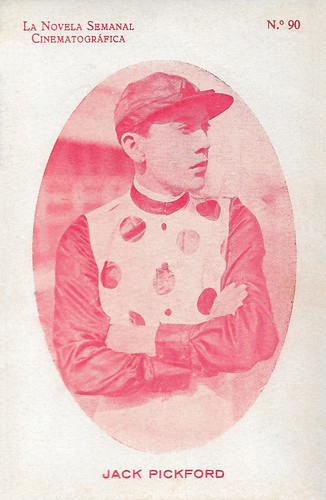
Spanish card by La Novela Semanal Cinematográfica, no. 90.
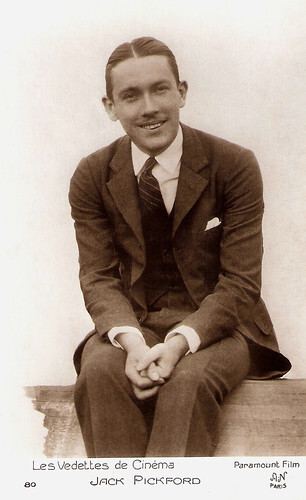
French postcard by A.N., Paris, no. 80. Photo: Paramount Film.
An excellent actor who never lived up to his potential
Jack Pickford was born John Charles Smith in 1896 in Toronto, Ontario, to John Charles Smith, an English immigrant odd-job man of Methodist background, and Charlotte Hennessy Smith, who was Irish Catholic. He was called Jack as a child. His alcoholic father left the family when Pickford was a young child. This incident left the family impoverished.
Out of desperation, Charlotte allowed Jack and his two sisters, Gladys and Lottie, to appear onstage, beginning with Gladys, the eldest. This proved a good source of income, and by 1900, the family had relocated to New York City, and the children were acting in plays across the United States.
Due to the work, the family was constantly separated until 1910 when Gladys signed with Biograph Studios. By this time, Gladys Smith had been transformed into Mary Pickford (Marie was her middle name, and Pickford was an old family name). Following suit, the Smiths changed their stage names to 'Pickford'. Soon after signing with Biograph, Mary secured jobs for all the family, including the then-14-year-old Jack.
When the Biograph Company headed West to Hollywood, only Mary was to go until Jack pleaded to join the company as well. Much to Mary's protest, Charlotte threw him on the train as it left the station. The company arrived in Hollywood, where Jack acted in bit parts during the stay. Mary soon became a well-known star, and by 1917 had signed a contract for $1 million with First National Pictures. As part of her contract, Mary saw to it that her family was brought along, giving the now-named Jack Pickford a lucrative contract with the company as well.
By the time he signed with First National, Pickford had played bit parts in 95 shorts and films. Though he was considered an excellent actor, Jack Pickford was seen as someone who never lived up to his potential. In 1917, he starred in one of his first major roles as Pip in the adaptation of Charles Dickens ' Great Expectations (Robert G. Vignola, Paul West, 1917) as well as the title role in Mark Twain's Tom Sawyer (William Desmond Taylor, 1917) and the follow-up Huck and Tom (William Desmond Taylor, 1918).
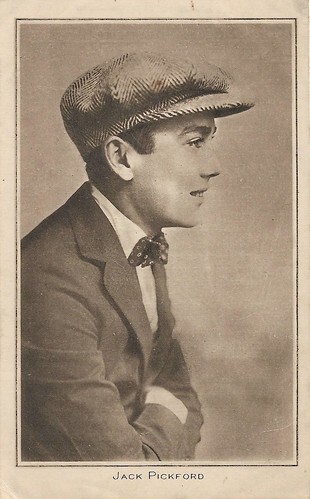
British postcard. On the back: publicity for the British journal Picturegoer and its postcard series Pictures.

British postcard. Photo: Walturdaw / Hardie (Frederick William Hardie), Aberdeen.
The All-American little brother of America’s Sweetheart
Jack Pickford's image was that of the All-American boy, with his sister being 'America’s Sweetheart'. Most of his films, especially those in the late 1910s, were both commercial and critical successes, making him a highly regarded name for himself. In early 1918, after the United States entered World War I, Jack joined the United States Navy as an enlisted sailor and was stationed at the Third Naval District in Manhattan, New York.
Using the famous Pickford name, he soon became involved in a scheme that allowed rich young men to pay bribes to avoid military service, as well as reportedly procuring young women for officers. The scandal almost got him court-martialed, but with the help of his family, he was exonerated. The others involved in the scandal were court-martialed, sentenced to up to three years in the brig and dishonorably discharged. Pickford returned to making films.
Despite his 'boy next door' image, Pickford's private life remained one of drinking and drug abuse, domestic violence, and womanising, culminating in the severe alcoholism that resulted in his early death. In the early days of Hollywood, movie studios were able to cover up almost all of their stars' misbehaviour, but within the Hollywood crowd, Jack Pickford's behind-the-scenes activities made him a legend in his own time. Pickford met actress and Ziegfeld girl Olive Thomas at a beach cafe on the Santa Monica Pier. Thomas was just as wild as Pickford. Pickford and Thomas eloped in 1916 in New Jersey. None of their family was present, and their only witness was Thomas Meighan . The couple had no children of their own, though, in 1920, they adopted Olive's then-six-year-old nephew when his mother died.
Although by most accounts Olive was the love of Pickford's life, the marriage was stormy and filled with highly charged conflict, followed by lavish making up through the exchange of expensive gifts. For many years, the Pickfords had intended to vacation together, and with their marriage on the rocks, the couple decided to take a second honeymoon. In August 1920, the pair traveled to Paris, hoping to combine a vacation with some film preparations. The couple went out for a night of entertainment and partying at the famous bistros in the Montparnasse Quarter of Paris.
They returned to their room in the Hôtel Ritz around 3:00 a.m. It was rumored that Thomas may have taken cocaine that night, though it was never proven. She was intoxicated and tired and took a large dose of mercury bichloride, a common item for bathroom cleaning. She was taken to the American Hospital in the Paris suburb of Neuilly, where Pickford, together with his former brother-in-law Owen Moore, remained at her side until she succumbed to the poison a few days later. Rumors arose that she had either tried to commit suicide or had been murdered. A police investigation followed, as well as an autopsy, and Thomas's death was ruled accidental.
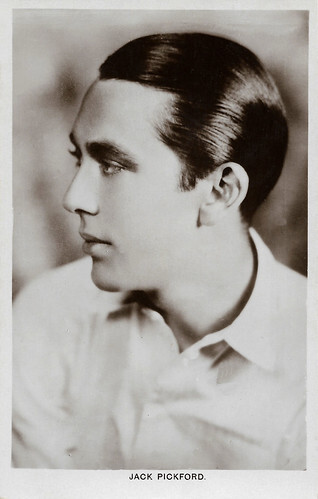
British postcard in the Picturegoer Series, London, no. 231.
An abusive husband due to drug abuse and alcoholism
Jack Pickford married two more times. In 1922, he married Marilyn Miller, a celebrated Broadway dancer and former Ziegfeld girl, at his sister and brother-in-law's famed home, Pickfair. By most accounts, it was an abusive marriage due to Pickford's drug abuse and alcoholism. They separated in 1926, and Miller was granted a French divorce in November 1927.
Some of his better films during this time included The Little Shepherd of Kingdom Come (Wallace Worsley, 1920), The Man Who Had Everything (Alfred E. Green, 1920), and Waking Up the Town (James Cruze, 1925). By 1923, his roles had gone from several a year to one. In 1928, he finished his last film, acting as Clyde Baxter in the part-talking gangster film Gang War (Bert Glennon, 1928).
Through the years, he dabbled in screenwriting and directing. He was given co-director credit for a couple of his sister Mary Pickford 's films: Little Lord Fauntleroy (Alfred E. Green, Jack Pickford, 1921) and Through the Back Door (Alfred E. Green, Jack Pickford, 1921). However, he never pursued either form further. Pickford's final marriage was to Mary Mulhern, age 22, and a former Ziegfeld girl, whom he married in 1930. Within three months, Pickford grew increasingly volatile towards Mulhern. After two years, Mulhern left Pickford, claiming he had mistreated her throughout the marriage. She was granted an interlocutory divorce in February 1932, which had yet to be finalised at the time of Pickford's death.
In 1932, Pickford visited his sister Mary at Pickfair. According to Mary, he looked ill and emaciated; his clothes were hanging on him as if he were a clothes hanger. Jack Pickford, at age 36, died at the American Hospital of Paris in 1933. The cause for his death was listed as "progressive multiple neuritides which attacked all the nerve centers". This was believed to be due to his alcoholism.
Mary Pickford arranged for his body to be returned to Los Angeles, where he was interred in the private Pickford plot at Forest Lawn Memorial Park, Glendale. All in all, Pickford appeared in more than 130 films between 1908 and 1928. For his contribution to the film industry, Jack Pickford has a star on the Hollywood Walk of Fame at 1523 Vine Street.
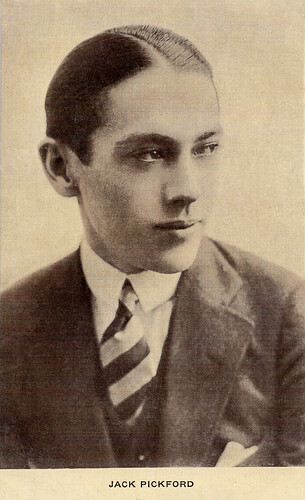
American postcard by Kraus Mfg. Co., N.Y. At the backside, the film The Mystery of No. 47 was promoted. It was shown on 29 April 1913 at the New Magnet, Danville. On the programme were also the two-part comedy The Brass Monkey and an 'Atletic Picture'. ( IMDb only mentions a 1917 version of The Mystery of No. 47).
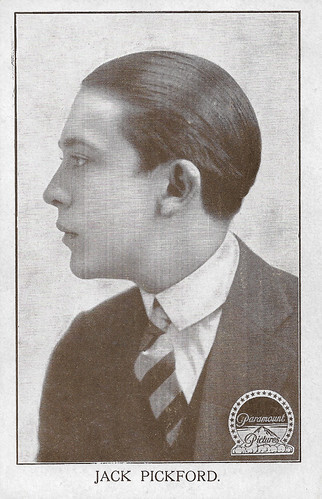
British postcard by R.F. Hunger, London. Photo: Paramount.
Sources: (IMDb), Wikipedia and .

Spanish card by La Novela Semanal Cinematográfica, no. 90.

French postcard by A.N., Paris, no. 80. Photo: Paramount Film.
An excellent actor who never lived up to his potential
Jack Pickford was born John Charles Smith in 1896 in Toronto, Ontario, to John Charles Smith, an English immigrant odd-job man of Methodist background, and Charlotte Hennessy Smith, who was Irish Catholic. He was called Jack as a child. His alcoholic father left the family when Pickford was a young child. This incident left the family impoverished.
Out of desperation, Charlotte allowed Jack and his two sisters, Gladys and Lottie, to appear onstage, beginning with Gladys, the eldest. This proved a good source of income, and by 1900, the family had relocated to New York City, and the children were acting in plays across the United States.
Due to the work, the family was constantly separated until 1910 when Gladys signed with Biograph Studios. By this time, Gladys Smith had been transformed into Mary Pickford (Marie was her middle name, and Pickford was an old family name). Following suit, the Smiths changed their stage names to 'Pickford'. Soon after signing with Biograph, Mary secured jobs for all the family, including the then-14-year-old Jack.
When the Biograph Company headed West to Hollywood, only Mary was to go until Jack pleaded to join the company as well. Much to Mary's protest, Charlotte threw him on the train as it left the station. The company arrived in Hollywood, where Jack acted in bit parts during the stay. Mary soon became a well-known star, and by 1917 had signed a contract for $1 million with First National Pictures. As part of her contract, Mary saw to it that her family was brought along, giving the now-named Jack Pickford a lucrative contract with the company as well.
By the time he signed with First National, Pickford had played bit parts in 95 shorts and films. Though he was considered an excellent actor, Jack Pickford was seen as someone who never lived up to his potential. In 1917, he starred in one of his first major roles as Pip in the adaptation of Charles Dickens ' Great Expectations (Robert G. Vignola, Paul West, 1917) as well as the title role in Mark Twain's Tom Sawyer (William Desmond Taylor, 1917) and the follow-up Huck and Tom (William Desmond Taylor, 1918).

British postcard. On the back: publicity for the British journal Picturegoer and its postcard series Pictures.

British postcard. Photo: Walturdaw / Hardie (Frederick William Hardie), Aberdeen.
The All-American little brother of America’s Sweetheart
Jack Pickford's image was that of the All-American boy, with his sister being 'America’s Sweetheart'. Most of his films, especially those in the late 1910s, were both commercial and critical successes, making him a highly regarded name for himself. In early 1918, after the United States entered World War I, Jack joined the United States Navy as an enlisted sailor and was stationed at the Third Naval District in Manhattan, New York.
Using the famous Pickford name, he soon became involved in a scheme that allowed rich young men to pay bribes to avoid military service, as well as reportedly procuring young women for officers. The scandal almost got him court-martialed, but with the help of his family, he was exonerated. The others involved in the scandal were court-martialed, sentenced to up to three years in the brig and dishonorably discharged. Pickford returned to making films.
Despite his 'boy next door' image, Pickford's private life remained one of drinking and drug abuse, domestic violence, and womanising, culminating in the severe alcoholism that resulted in his early death. In the early days of Hollywood, movie studios were able to cover up almost all of their stars' misbehaviour, but within the Hollywood crowd, Jack Pickford's behind-the-scenes activities made him a legend in his own time. Pickford met actress and Ziegfeld girl Olive Thomas at a beach cafe on the Santa Monica Pier. Thomas was just as wild as Pickford. Pickford and Thomas eloped in 1916 in New Jersey. None of their family was present, and their only witness was Thomas Meighan . The couple had no children of their own, though, in 1920, they adopted Olive's then-six-year-old nephew when his mother died.
Although by most accounts Olive was the love of Pickford's life, the marriage was stormy and filled with highly charged conflict, followed by lavish making up through the exchange of expensive gifts. For many years, the Pickfords had intended to vacation together, and with their marriage on the rocks, the couple decided to take a second honeymoon. In August 1920, the pair traveled to Paris, hoping to combine a vacation with some film preparations. The couple went out for a night of entertainment and partying at the famous bistros in the Montparnasse Quarter of Paris.
They returned to their room in the Hôtel Ritz around 3:00 a.m. It was rumored that Thomas may have taken cocaine that night, though it was never proven. She was intoxicated and tired and took a large dose of mercury bichloride, a common item for bathroom cleaning. She was taken to the American Hospital in the Paris suburb of Neuilly, where Pickford, together with his former brother-in-law Owen Moore, remained at her side until she succumbed to the poison a few days later. Rumors arose that she had either tried to commit suicide or had been murdered. A police investigation followed, as well as an autopsy, and Thomas's death was ruled accidental.

British postcard in the Picturegoer Series, London, no. 231.
An abusive husband due to drug abuse and alcoholism
Jack Pickford married two more times. In 1922, he married Marilyn Miller, a celebrated Broadway dancer and former Ziegfeld girl, at his sister and brother-in-law's famed home, Pickfair. By most accounts, it was an abusive marriage due to Pickford's drug abuse and alcoholism. They separated in 1926, and Miller was granted a French divorce in November 1927.
Some of his better films during this time included The Little Shepherd of Kingdom Come (Wallace Worsley, 1920), The Man Who Had Everything (Alfred E. Green, 1920), and Waking Up the Town (James Cruze, 1925). By 1923, his roles had gone from several a year to one. In 1928, he finished his last film, acting as Clyde Baxter in the part-talking gangster film Gang War (Bert Glennon, 1928).
Through the years, he dabbled in screenwriting and directing. He was given co-director credit for a couple of his sister Mary Pickford 's films: Little Lord Fauntleroy (Alfred E. Green, Jack Pickford, 1921) and Through the Back Door (Alfred E. Green, Jack Pickford, 1921). However, he never pursued either form further. Pickford's final marriage was to Mary Mulhern, age 22, and a former Ziegfeld girl, whom he married in 1930. Within three months, Pickford grew increasingly volatile towards Mulhern. After two years, Mulhern left Pickford, claiming he had mistreated her throughout the marriage. She was granted an interlocutory divorce in February 1932, which had yet to be finalised at the time of Pickford's death.
In 1932, Pickford visited his sister Mary at Pickfair. According to Mary, he looked ill and emaciated; his clothes were hanging on him as if he were a clothes hanger. Jack Pickford, at age 36, died at the American Hospital of Paris in 1933. The cause for his death was listed as "progressive multiple neuritides which attacked all the nerve centers". This was believed to be due to his alcoholism.
Mary Pickford arranged for his body to be returned to Los Angeles, where he was interred in the private Pickford plot at Forest Lawn Memorial Park, Glendale. All in all, Pickford appeared in more than 130 films between 1908 and 1928. For his contribution to the film industry, Jack Pickford has a star on the Hollywood Walk of Fame at 1523 Vine Street.

American postcard by Kraus Mfg. Co., N.Y. At the backside, the film The Mystery of No. 47 was promoted. It was shown on 29 April 1913 at the New Magnet, Danville. On the programme were also the two-part comedy The Brass Monkey and an 'Atletic Picture'. ( IMDb only mentions a 1917 version of The Mystery of No. 47).

British postcard by R.F. Hunger, London. Photo: Paramount.
Sources: (IMDb), Wikipedia and .
Published on May 18, 2025 22:00
May 17, 2025
Il richiamo (1921)
Diva Maria Jacobini, Lido Manetti and Carlo Benetti starred in the Italian silent film Il richiamo / The Call from the Past (1921), directed by Gennaro Righelli. The script by Luciano Doria was based on a story by Fausto Maria Martini.
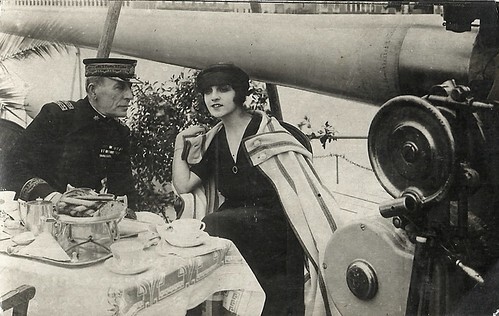
Italian postcard by Ed. S.I.C., Roma. Maria Jacobini in Il richiamo / The Call from the Past (Gennaro Righelli, 1921). Publicity for the Corso Cinema Teatro in Rome.
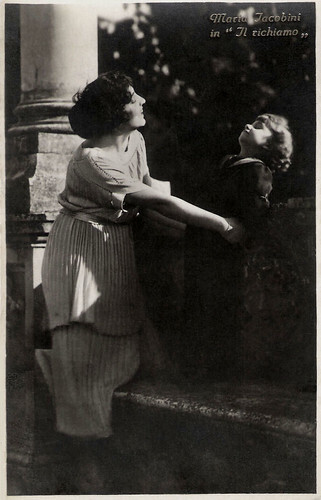
Italian postcard by G.B. Falci, Milano, no. 92. Photo: Fert. Maria Jacobini in Il richiamo / The Call from the Past (Gennaro Righelli, 1921).
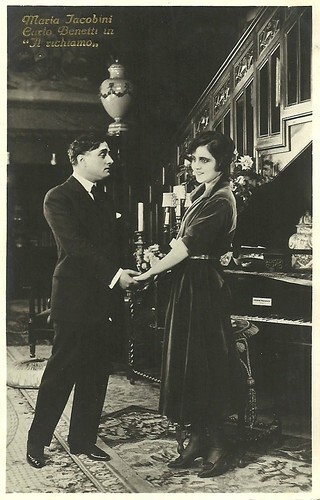
Italian postcard by Ed. G.B. Falci, Milano, no. 95. Photo: Fert. Maria Jacobini and Carlo Benetti in Il richiamo / The Call from the Past (Gennaro Righelli, 1921).
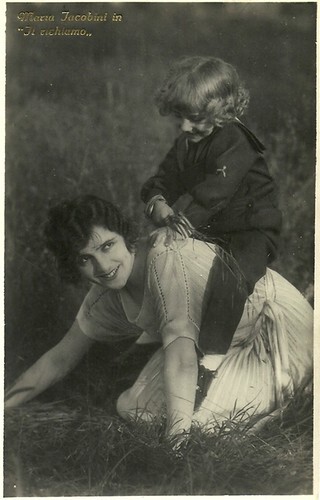
Italian postcard by Ed. G.B. Falci, Milano, no. 183. Photo: Fert. Maria Jacobini in Il richiamo / The Call from the Past (Gennaro Righelli, 1921).
A dramatic colour change in a central scene
The Italian silent melodrama Il richiamo / The Call from the Past (1921) directed by Gennaro Righelli and starring his future wife Maria Jacobini , was produced by the Fert Studios in Turin and based on a story by Fausto Maria Martini.
Maria Jacobini plays a young widow, Giovanna Landi, who loses her own child. She then adopts a boy, Santino, from an orphanage and takes care of him. Once Santino has grown a man ( Lido Manetti also known as Arnold Kent), he falls in love with his adoptive mother. She is disappointed and disappears from his life, while he doesn't understand.
Il richiamo had its Roman first night on 17 October 1921. At the time, the Italian press remarked that Maria Jacobini remained a great actress, but Jacobini's beauty was too much hidden under makeup, to make her look older. The other actors were Lido Manetti , Carlo Benetti , Cecyl Tryan and Luigi Duse. The exteriors, shot in Venice by cinematographer Tullio Chiarini, were praised too, but the film's story had too many sidepaths, making it unnecessarily complicated.
A print of this film was discovered in the Komiya Collection at the National Film Center in Tokyo. In 1988, Komiya Takahashi donated what was left of the great collection of his father Komiya Tomijiro (1897-1975) to this centre. Komiya senior, son of a restaurateur, had grown up in Tokyo’s entertainment district, Asakusa, and collected the films of his youth, European productions from 1907 to 1920.
As they catalogued the films and drew up condition reports, Hiroshi Komatsu and the Film Center archivists realised that many were decomposed. But what did survive was precious enough – many unique and matchless colour prints – which were duplicated in 1991. Il richiamo / The Call from the Past (1921) is one of the few Komiya Collection films to survive completely. Thanks to the nitrate decomposition, the character played by Maria Jacobini undergoes a dramatic colour change in a central scene of the film… In 2012, a restored version was shown at Il Cinema Ritrovato in Bologna.
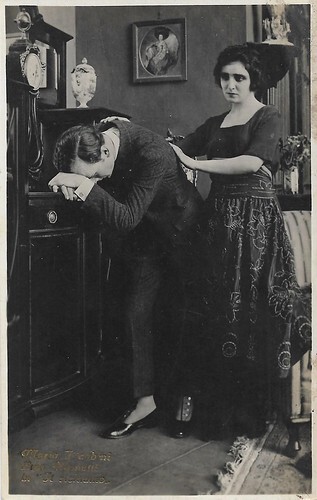
Italian postcard by Ed. G.B. Falci, Milano, no. 101. Photo: Fert. Maria Jacobini and Lido Manetti in Il richiamo / The Call from the Past (Gennaro Righelli, 1921).
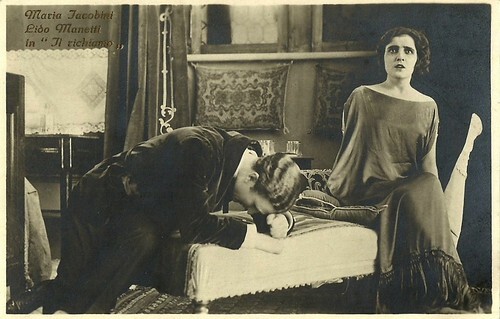
Italian postcard by Ed. G.B. Falci, Milano, no. 102. Photo: Fert. Maria Jacobini and Lido Manetti (Arnold Kent) in Il richiamo / The Call from the Past (Gennaro Righelli, 1921).
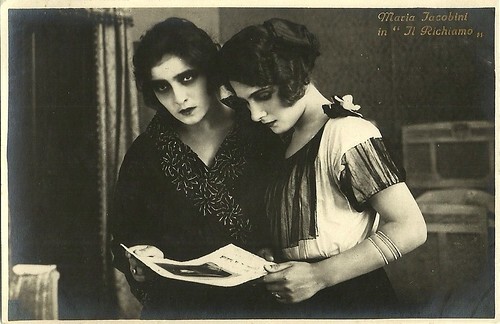
Italian postcard by Ed. G.B. Falci, Milano, no. 105. Photo: Fert. Maria Jacobini and Cecyl Tryan in Il richiamo / The Call from the Past (Gennaro Righelli, 1921).
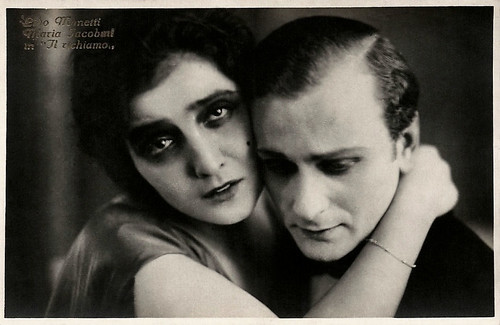
Italian postcard by G.B. Falci, Milano, no. 67. Photo: Fert. Maria Jacobini and Lido Manetti in Il richiamo / The Call from the Past (Gennaro Righelli, 1921).
Sources: Vittorio Martinelli (Il cinema muto italiano, 1921-1922 - Italian), Il Cinema Ritrovato, Wikipedia and IMDb.

Italian postcard by Ed. S.I.C., Roma. Maria Jacobini in Il richiamo / The Call from the Past (Gennaro Righelli, 1921). Publicity for the Corso Cinema Teatro in Rome.

Italian postcard by G.B. Falci, Milano, no. 92. Photo: Fert. Maria Jacobini in Il richiamo / The Call from the Past (Gennaro Righelli, 1921).

Italian postcard by Ed. G.B. Falci, Milano, no. 95. Photo: Fert. Maria Jacobini and Carlo Benetti in Il richiamo / The Call from the Past (Gennaro Righelli, 1921).

Italian postcard by Ed. G.B. Falci, Milano, no. 183. Photo: Fert. Maria Jacobini in Il richiamo / The Call from the Past (Gennaro Righelli, 1921).
A dramatic colour change in a central scene
The Italian silent melodrama Il richiamo / The Call from the Past (1921) directed by Gennaro Righelli and starring his future wife Maria Jacobini , was produced by the Fert Studios in Turin and based on a story by Fausto Maria Martini.
Maria Jacobini plays a young widow, Giovanna Landi, who loses her own child. She then adopts a boy, Santino, from an orphanage and takes care of him. Once Santino has grown a man ( Lido Manetti also known as Arnold Kent), he falls in love with his adoptive mother. She is disappointed and disappears from his life, while he doesn't understand.
Il richiamo had its Roman first night on 17 October 1921. At the time, the Italian press remarked that Maria Jacobini remained a great actress, but Jacobini's beauty was too much hidden under makeup, to make her look older. The other actors were Lido Manetti , Carlo Benetti , Cecyl Tryan and Luigi Duse. The exteriors, shot in Venice by cinematographer Tullio Chiarini, were praised too, but the film's story had too many sidepaths, making it unnecessarily complicated.
A print of this film was discovered in the Komiya Collection at the National Film Center in Tokyo. In 1988, Komiya Takahashi donated what was left of the great collection of his father Komiya Tomijiro (1897-1975) to this centre. Komiya senior, son of a restaurateur, had grown up in Tokyo’s entertainment district, Asakusa, and collected the films of his youth, European productions from 1907 to 1920.
As they catalogued the films and drew up condition reports, Hiroshi Komatsu and the Film Center archivists realised that many were decomposed. But what did survive was precious enough – many unique and matchless colour prints – which were duplicated in 1991. Il richiamo / The Call from the Past (1921) is one of the few Komiya Collection films to survive completely. Thanks to the nitrate decomposition, the character played by Maria Jacobini undergoes a dramatic colour change in a central scene of the film… In 2012, a restored version was shown at Il Cinema Ritrovato in Bologna.

Italian postcard by Ed. G.B. Falci, Milano, no. 101. Photo: Fert. Maria Jacobini and Lido Manetti in Il richiamo / The Call from the Past (Gennaro Righelli, 1921).

Italian postcard by Ed. G.B. Falci, Milano, no. 102. Photo: Fert. Maria Jacobini and Lido Manetti (Arnold Kent) in Il richiamo / The Call from the Past (Gennaro Righelli, 1921).

Italian postcard by Ed. G.B. Falci, Milano, no. 105. Photo: Fert. Maria Jacobini and Cecyl Tryan in Il richiamo / The Call from the Past (Gennaro Righelli, 1921).

Italian postcard by G.B. Falci, Milano, no. 67. Photo: Fert. Maria Jacobini and Lido Manetti in Il richiamo / The Call from the Past (Gennaro Righelli, 1921).
Sources: Vittorio Martinelli (Il cinema muto italiano, 1921-1922 - Italian), Il Cinema Ritrovato, Wikipedia and IMDb.
Published on May 17, 2025 22:00
May 16, 2025
Nathalie Baye
French film, television, and stage actress Nathalie Baye (1948) began her career in 1970 and has appeared in more than 80 films. She has won more than ten acting awards, including the Volpi Cup at the Venice Film Festival for Une liaison pornographique (1999). Baye won four Césars, for Sauve qui peut (la vie) (1980), Une étrange affaire (1981), La Balance (1982) and Le petit lieutenant (2005).
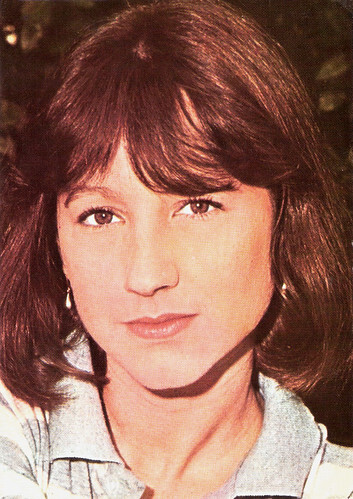
Romanian postcard by Casa Filmului Acin.

French postcard at Editions P.I., Paris, no. 3647. Photo: Eva Sereny / Sygma.
Recognised as one of France's leading actresses
Nathalie Marie Andrée Baye was born in Mainneville, Normandy, in 1948. She grew up in unconventional circumstances as the daughter of a bohemian painter couple, Claude Baye and Denise Coustet. She was dyslexic, dropped out of school at the age of fourteen and took ballet lessons in Monaco. Three years later, at age 17, she toured with a dance company in the United States. She stayed in New York to complete her training with the Ballets Russes and to broaden her horizons.
On her return, she attended the Cours Simon and then the Conservatoire, which she completed in 1972. Baye made her film debut as Giselle in Faustine et le bel été / Faustine and the Beautiful Summer (Nina Companeez, 1972), starring Isabelle Adjani . The next year, she became famous with the supporting role of the script girl Joëlle in the film La Nuit américaine / Day for Night (1973) by François Truffaut .
After that, she worked with another great director, Maurice Pialat, on La gueule ouverte / The Mouth Agape (1974). Other supporting roles followed, including a brief appearance in Truffaut's L'Homme qui aimait les femmes / The Man Who Loved Women (François Truffaut, 1977). Throughout the 1970s, she played the good girlfriend or nice provincial girl in film and television. She played her first major leading role as Truffaut's partner in his film drama La Chambre verte / The Green Room (François Truffaut, 1978).
Since the early 1980s, she has been recognised as one of France's leading actresses, thanks to performances such as in Claude Goretta's La Provinciale / The Girl from Lorraine (1981). Baye has been honoured with four César awards: Best Supporting Actress in 1981 for Sauve qui peut (la vie) / Every Man for Himself (Jean-Luc Godard, 1980) and 1982 for Une étrange affair / Strange Affair (Pierre Granier-Deferre, 1981) as well as Best Actress in a Leading Role in 1983 for La Balance / The Nark (Bob Swaim, 1982).
After changing her image by playing a streetwalker in La Balance, she widened her scope with more obscure characters in J'ai épousé une ombre / I Married a Shadow (Robin Davis, 1983) and En toute innocence / No Harm Intended (Alain Jessua, 1988). In 1986, she returned to the theatre with an interpretation of 'Adriana Monti'. At the Venice Film Festival in 1999, she received the award for Best Actress for her role in Une liaison pornographique / A Pornographic Relationship (Frédéric Fonteyne, 1999) with Sergi Lopéz. Her other film successes include her role as a teacher in Une semaine de vacances / Holidays for a Week (Bertrand Tavernier, 1980) and she was one the beauticians in the highly acclaimed Vénus Beauté (Institut) / Venus Beauty Institute (Tonie Marshall, 1999), which won multiple César Awards, including for Best Film.
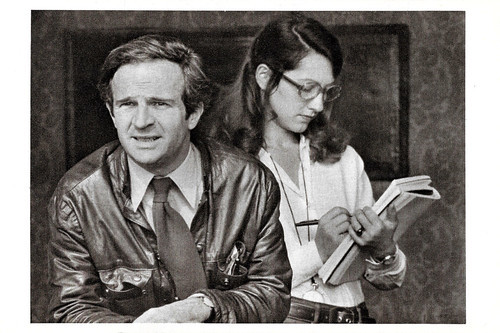
French postcard by Editions La Malibran, Paris, no. CF 32. Photo: Pierre Zucca. François Truffaut and Nathalie Baye in La Nuit Américaine (François Truffaut, 1973).
A celebrity couple with a French Rock and Roll legend
Nathalie Baye has appeared in more than 65 films. Most of these are French-language, though not exclusively. For instance, she starred in the American films Two People (Robert Wise, 1972) with Lindsay Wagner and Peter Fonda, The Man Inside (Bobby Roth, 1990), alongside Jürgen Prochnow and Monique van de Ven, and Catch Me If You Can (Steven Spielberg, 2002) starring Leonardo DiCaprio and Tom Hanks .
From 1982 to 1986, Baye formed a celebrity couple with French Rock and Roll legend Johnny Hallyday . Together, they made the film Détective (1984), directed by Jean-Luc Godard . With Hallyday, she had a daughter, Laura Smet, in 1983.
Laura Smet has also played several film roles since 2003. In 2017, Baye starred for the first time with her daughter in an episode of the TV series Dix pour Cent / Call My Agent! (2015) about the lives and jobs of people working at a talent agency in Paris. The two women were reunited for the first time in the cinema by Xavier Beauvois in Les Gardiennes / The Guardians, a historical drama set in 1915.
In 2006, Nathalie Baye won her fourth César for her role as a middle-aged woman detective in Le petit lieutenant / The Young Lieutenant (Xavier Beauvois, 2005). Young Canadian film prodigy Xavier Dolan offered her the role of the mother of a man wanting to have a sex change in Laurence Anyways (Xavier Dolan, 2012).
More recent films in which she appeared include the French drama-thriller La Volante / The Assistant (Christophe Ali, Nicolas Bonilauri, 2015), the drama Juste la fin du monde / It's Only the End of the World (Xavier Dolan, 2016) and the historical drama Downton Abbey: A New Era (Simon Curtis, 2022) from a screenplay by Julian Fellowes. It is the sequel to Downton Abbey (Michael Engler, 2019), based on the television series of the same name created by Fellowes.
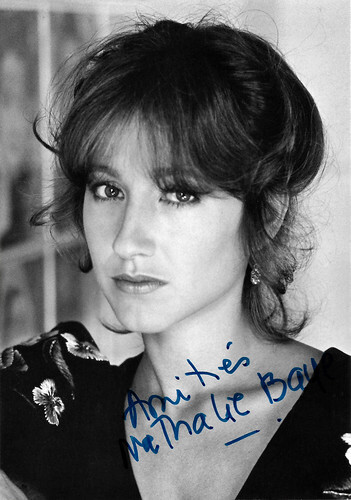
French autograph card by Editions P.I., Paris. Photo: Sygma.
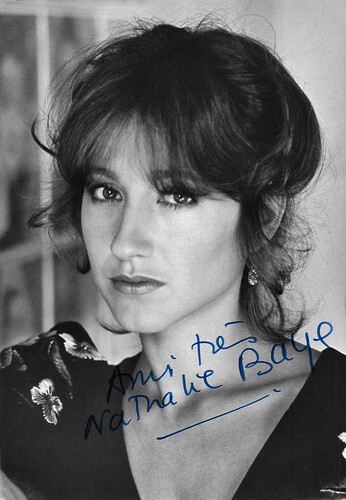
French autograph card by Editions P.I., Paris. Photo: Sygma. Check out the differences.
Sources: Allociné (French), Wikipedia (Dutch, French and English) and .

Romanian postcard by Casa Filmului Acin.

French postcard at Editions P.I., Paris, no. 3647. Photo: Eva Sereny / Sygma.
Recognised as one of France's leading actresses
Nathalie Marie Andrée Baye was born in Mainneville, Normandy, in 1948. She grew up in unconventional circumstances as the daughter of a bohemian painter couple, Claude Baye and Denise Coustet. She was dyslexic, dropped out of school at the age of fourteen and took ballet lessons in Monaco. Three years later, at age 17, she toured with a dance company in the United States. She stayed in New York to complete her training with the Ballets Russes and to broaden her horizons.
On her return, she attended the Cours Simon and then the Conservatoire, which she completed in 1972. Baye made her film debut as Giselle in Faustine et le bel été / Faustine and the Beautiful Summer (Nina Companeez, 1972), starring Isabelle Adjani . The next year, she became famous with the supporting role of the script girl Joëlle in the film La Nuit américaine / Day for Night (1973) by François Truffaut .
After that, she worked with another great director, Maurice Pialat, on La gueule ouverte / The Mouth Agape (1974). Other supporting roles followed, including a brief appearance in Truffaut's L'Homme qui aimait les femmes / The Man Who Loved Women (François Truffaut, 1977). Throughout the 1970s, she played the good girlfriend or nice provincial girl in film and television. She played her first major leading role as Truffaut's partner in his film drama La Chambre verte / The Green Room (François Truffaut, 1978).
Since the early 1980s, she has been recognised as one of France's leading actresses, thanks to performances such as in Claude Goretta's La Provinciale / The Girl from Lorraine (1981). Baye has been honoured with four César awards: Best Supporting Actress in 1981 for Sauve qui peut (la vie) / Every Man for Himself (Jean-Luc Godard, 1980) and 1982 for Une étrange affair / Strange Affair (Pierre Granier-Deferre, 1981) as well as Best Actress in a Leading Role in 1983 for La Balance / The Nark (Bob Swaim, 1982).
After changing her image by playing a streetwalker in La Balance, she widened her scope with more obscure characters in J'ai épousé une ombre / I Married a Shadow (Robin Davis, 1983) and En toute innocence / No Harm Intended (Alain Jessua, 1988). In 1986, she returned to the theatre with an interpretation of 'Adriana Monti'. At the Venice Film Festival in 1999, she received the award for Best Actress for her role in Une liaison pornographique / A Pornographic Relationship (Frédéric Fonteyne, 1999) with Sergi Lopéz. Her other film successes include her role as a teacher in Une semaine de vacances / Holidays for a Week (Bertrand Tavernier, 1980) and she was one the beauticians in the highly acclaimed Vénus Beauté (Institut) / Venus Beauty Institute (Tonie Marshall, 1999), which won multiple César Awards, including for Best Film.

French postcard by Editions La Malibran, Paris, no. CF 32. Photo: Pierre Zucca. François Truffaut and Nathalie Baye in La Nuit Américaine (François Truffaut, 1973).
A celebrity couple with a French Rock and Roll legend
Nathalie Baye has appeared in more than 65 films. Most of these are French-language, though not exclusively. For instance, she starred in the American films Two People (Robert Wise, 1972) with Lindsay Wagner and Peter Fonda, The Man Inside (Bobby Roth, 1990), alongside Jürgen Prochnow and Monique van de Ven, and Catch Me If You Can (Steven Spielberg, 2002) starring Leonardo DiCaprio and Tom Hanks .
From 1982 to 1986, Baye formed a celebrity couple with French Rock and Roll legend Johnny Hallyday . Together, they made the film Détective (1984), directed by Jean-Luc Godard . With Hallyday, she had a daughter, Laura Smet, in 1983.
Laura Smet has also played several film roles since 2003. In 2017, Baye starred for the first time with her daughter in an episode of the TV series Dix pour Cent / Call My Agent! (2015) about the lives and jobs of people working at a talent agency in Paris. The two women were reunited for the first time in the cinema by Xavier Beauvois in Les Gardiennes / The Guardians, a historical drama set in 1915.
In 2006, Nathalie Baye won her fourth César for her role as a middle-aged woman detective in Le petit lieutenant / The Young Lieutenant (Xavier Beauvois, 2005). Young Canadian film prodigy Xavier Dolan offered her the role of the mother of a man wanting to have a sex change in Laurence Anyways (Xavier Dolan, 2012).
More recent films in which she appeared include the French drama-thriller La Volante / The Assistant (Christophe Ali, Nicolas Bonilauri, 2015), the drama Juste la fin du monde / It's Only the End of the World (Xavier Dolan, 2016) and the historical drama Downton Abbey: A New Era (Simon Curtis, 2022) from a screenplay by Julian Fellowes. It is the sequel to Downton Abbey (Michael Engler, 2019), based on the television series of the same name created by Fellowes.

French autograph card by Editions P.I., Paris. Photo: Sygma.

French autograph card by Editions P.I., Paris. Photo: Sygma. Check out the differences.
Sources: Allociné (French), Wikipedia (Dutch, French and English) and .
Published on May 16, 2025 22:00
May 15, 2025
Bruce Willis
Bruce Willis (1955) is an American actor, producer and singer known for his wisecracking and hard-edged characters, often in spectacular action films. Thanks to blockbusters as Die Hard (1988), Pulp Fiction (1994) and The Sixth Sense (1999), he became one of the best-paid actors in Hollywood.

Romanian postcard by Polsib S.A., Dibiu. Photo: S.C.P. Vizual S.R.L., Bucuresti.

German collector card by Kino, 1990.
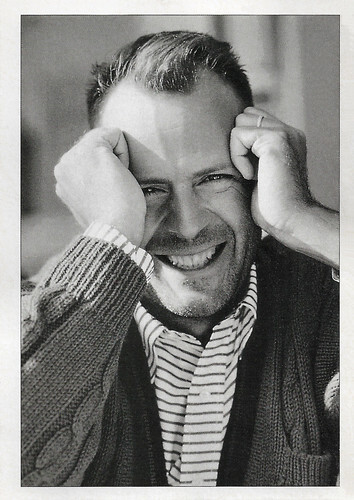
Italian postcard by CIAK. Photo: Alberto Tolot / UnoPress.
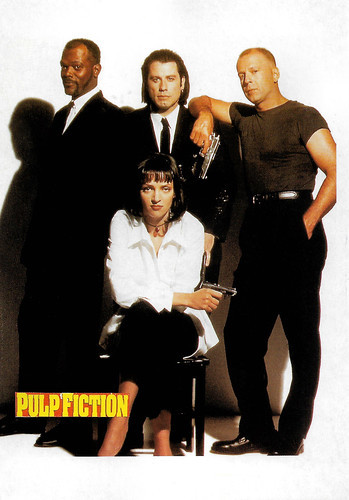
British postcard by Memory Card, no. 78. Samuel Jackson, John Travolta , Bruce Willis, and Uma Thurman in Pulp Fiction (Quentin Tarantino, 1994). Caption: Lobby card.
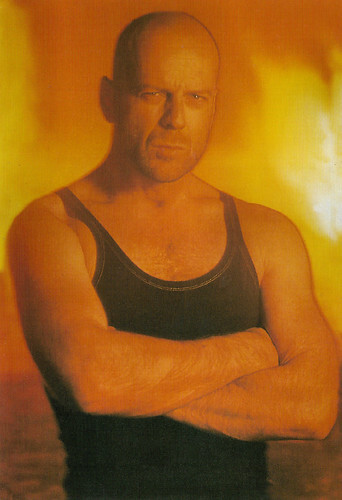
French postcard, Ref. C 674. Photo: Timothy White for Esquire.
Acting as therapy for his stammer
Walter Bruce Willis was born in 1955 in a basement in Idar-Oberstein in Rhineland-Palatinate, West Germany. He was the son of US soldier David Willis and his German wife, Marlene Kassel. He spent the first two years with his parents in Germany before the family moved to the United States in 1957. Together with his three younger siblings, he grew up in New Jersey.
As therapy for his stammer, he took up acting during his school years. After finishing high school, he took acting classes at Montclair State College and worked part-time at a chemical plant to pay for his lessons. Willis moved to New York to become an actor. Initially, these were roles in plays.
He became famous for his role as private eye David Addison in the romantic detective series Moonlighting (1985-1989), in which he co-starred with Cybill Shepherd. The TV series was honoured with an Emmy and a Golden Globe. As a singer, Willis had a top 10 hit in the Netherlands in 1987 with the song 'Under the Boardwalk', a cover of The Drifters. Another single, 'Respect Yourself', was a big hit in the United States and reached no. 5 on the Billboard Hot 100. In 1989, he released his last LP, If It Don't Kill You, It Just Makes You Stronger.' The record features blues and rhythm-and-blues songs.
He also began a film career. He worked twice with director Blake Edwards, the comedies Blind Date (1987) with Kim Basinger and Sunset (1988) with James Garner .
In 1988, he broke through as a film actor in the role of the police officer John McClane in the action film Die Hard (John McTiernan, 1988). He played John McClane, who only obeys his own rules and always has a casual quip on his lips. McClane single-handedly battled a gang of ruthless international thieves in a Los Angeles skyscraper. He reprised the role of McClane in the sequel, Die Hard 2 (Renny Harlin, 1990), set at a snowbound Washington's Dulles International Airport as a group of renegade Special Forces soldiers seek to repatriate a corrupt South American general. Excellent box office returns demanded a further sequel, Die Hard with a Vengeance (John McTiernan, 1995), this time co-starring Samuel L. Jackson as a cynical Harlem shop owner unwittingly thrust into assisting McClane during a terrorist bombing campaign in New York.
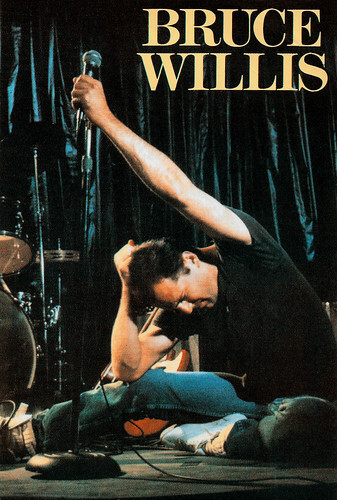
French postcard by Editions Musicartes, no. EM478.

American postcard by Buena Vista Pictures Distribution. Photo: Touchstone Home Video. Bruce Willis in Pulp Fiction (Quentin Tarantino, 1994). Caption: "He was dead before he ever stepped into the ring." The Boxer.
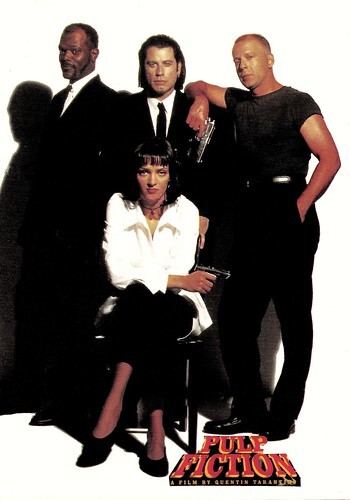
British postcard, no. MM 387. Samuel Jackson, Uma Thurman , John Travolta and Bruce Willis in Pulp Fiction (Quentin Tarantino, 1994).
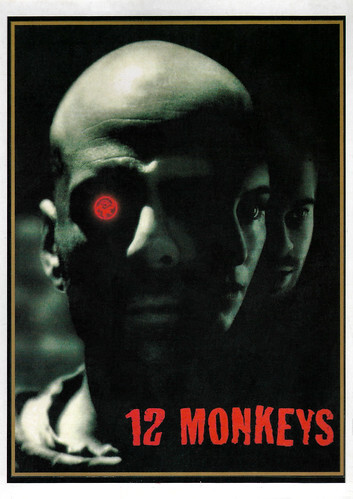
Vintage postcard by Memory Card, no. 175. Photo: Bruce Willis in 12 Monkeys (Terry Gilliam, 1995).
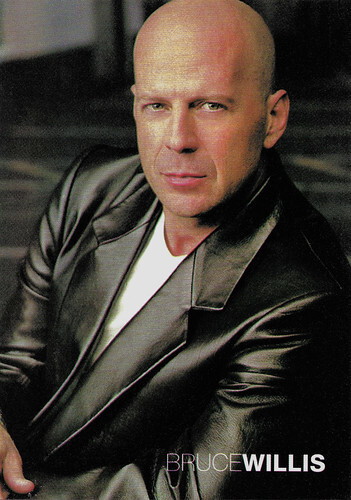
Vintgage postcard by Iauiuasinu, no. 0041. Photo: Norman Jean Roy.
Large-scale financial disasters that were savaged by the critics
Apart from his action films, such as the Die Hard series and The Last Boy Scout (Tony Scott, 1991), Bruce Willis had little commercial success until the mid-1990s. He tried to relativise his action image with roles in comedies such as the voice of Mikey, the baby in the popular family comedies Look Who's Talking (Amy Heckerling, 1989) and its sequel Look Who's Talking Too (Amy Heckerling, 1990), also starring John Travolta and Kirstie Alley.
The Bonfire of the Vanities (Brian De Palma, 1990) and Hudson Hawk (Michael Lehmann, 1991) were both large-scale financial disasters that were savaged by the critics. In 1994, he was cast by Quentin Tarantino in Pulp Fiction in the role of boxer Butch. His performance was praised by critics.
This was followed by further box office hits such as the apocalyptic thriller 12 Monkeys (Terry Gilliam, 1995), the Science-Fiction opus The Fifth Element (Luc Besson, 1997) and Armageddon (Michael Bay, 1998) with Ben Affleck. With films such as The Sixth Sense (M. Night Shyamalan, 1999) and Unbreakable (M. Night Shyamalan, 2000) with Samuel L. Jackson, he then devoted himself increasingly to dramas but also remained loyal to comedies and action films.
After some flops, Willis bounced back into the spotlight in the critically applauded Frank Miller graphic novel turned movie Sin City (Frank Miller, Quentin Tarantino, Robert Rodriguez, 2005), the voice of RJ the scheming raccoon in the animated hit Over the Hedge (Tim Johnson, Karey Kirkpatrick, 2006) and the high tech Die Hard 4.0 (Len Wiseman, 2007). In 2006, Bruce Willis received a star on the Hollywood Walk of Fame. According to the American Forbes Magazine, he was one of the best-paid actors in Hollywood at the time. Between June 2007 and June 2008, he received fees totalling USD 41 million.
Bruce Willis quit acting in 2022 when he was diagnosed with aphasia. In 2023, his family reported that Willis had frontotemporal dementia. Willis was married to actress Demi Moore from 1987 to 2000. They have three daughters, Rumer (1988), Scout LaRue (1991) and Tallulah Belle (1994). In 2009, Willis remarried 23 years younger actress cum model Emma Heming (1978). Together, they have two daughters.

French postcard, Ref. 1141. Bruce Willis in Le cinquième élément / The Fifth Element (Luc Besson, 1997).
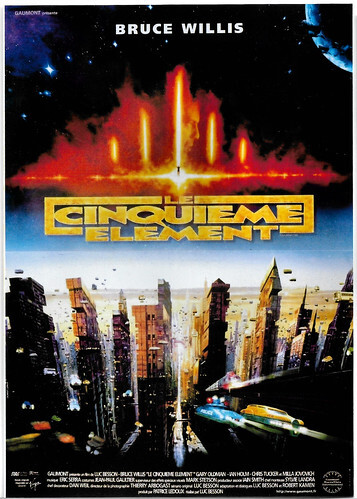
English postcard by Cinema. French poster by Gaumont for Le cinquième élément / The Fifth Element (Luc Besson, 1997).
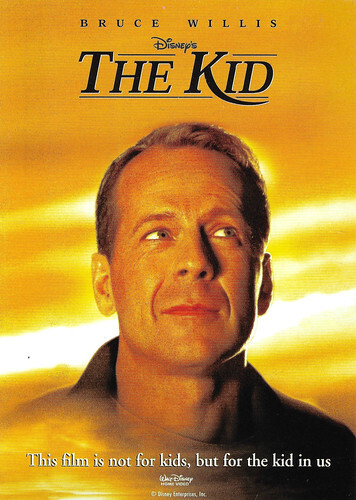
Dutch freecard by John v.d. Burg Indoor Media BV. Photo: Disney. Bruce Willis in The Kid (Jon Turteltaub, 2000).
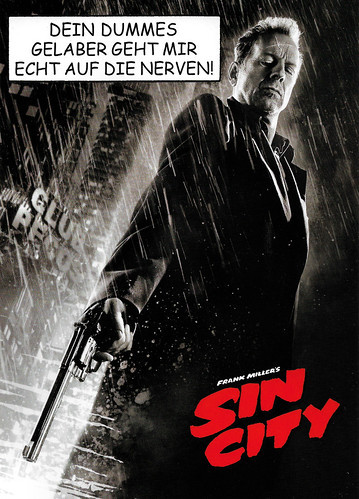
German postcard by Edgar Medien AG, no. 7.687. Image: Buena Vista / Miramax. Bruce Willis in Sin City (Frank Miller, Quentin Tarantino (special guest director), Robert Rodriguez, 2005). Caption: Your stupid talk really gets on my nerves!

French postcard. Image: Miramax. Photos: Rico Torres. French poster for Sin City (Frank Miller, Quentin Tarantino (special guest director), Robert Rodriguez, 2005).
Sources: Wikipedia (Dutch, German and English) and .

Romanian postcard by Polsib S.A., Dibiu. Photo: S.C.P. Vizual S.R.L., Bucuresti.

German collector card by Kino, 1990.

Italian postcard by CIAK. Photo: Alberto Tolot / UnoPress.

British postcard by Memory Card, no. 78. Samuel Jackson, John Travolta , Bruce Willis, and Uma Thurman in Pulp Fiction (Quentin Tarantino, 1994). Caption: Lobby card.

French postcard, Ref. C 674. Photo: Timothy White for Esquire.
Acting as therapy for his stammer
Walter Bruce Willis was born in 1955 in a basement in Idar-Oberstein in Rhineland-Palatinate, West Germany. He was the son of US soldier David Willis and his German wife, Marlene Kassel. He spent the first two years with his parents in Germany before the family moved to the United States in 1957. Together with his three younger siblings, he grew up in New Jersey.
As therapy for his stammer, he took up acting during his school years. After finishing high school, he took acting classes at Montclair State College and worked part-time at a chemical plant to pay for his lessons. Willis moved to New York to become an actor. Initially, these were roles in plays.
He became famous for his role as private eye David Addison in the romantic detective series Moonlighting (1985-1989), in which he co-starred with Cybill Shepherd. The TV series was honoured with an Emmy and a Golden Globe. As a singer, Willis had a top 10 hit in the Netherlands in 1987 with the song 'Under the Boardwalk', a cover of The Drifters. Another single, 'Respect Yourself', was a big hit in the United States and reached no. 5 on the Billboard Hot 100. In 1989, he released his last LP, If It Don't Kill You, It Just Makes You Stronger.' The record features blues and rhythm-and-blues songs.
He also began a film career. He worked twice with director Blake Edwards, the comedies Blind Date (1987) with Kim Basinger and Sunset (1988) with James Garner .
In 1988, he broke through as a film actor in the role of the police officer John McClane in the action film Die Hard (John McTiernan, 1988). He played John McClane, who only obeys his own rules and always has a casual quip on his lips. McClane single-handedly battled a gang of ruthless international thieves in a Los Angeles skyscraper. He reprised the role of McClane in the sequel, Die Hard 2 (Renny Harlin, 1990), set at a snowbound Washington's Dulles International Airport as a group of renegade Special Forces soldiers seek to repatriate a corrupt South American general. Excellent box office returns demanded a further sequel, Die Hard with a Vengeance (John McTiernan, 1995), this time co-starring Samuel L. Jackson as a cynical Harlem shop owner unwittingly thrust into assisting McClane during a terrorist bombing campaign in New York.

French postcard by Editions Musicartes, no. EM478.

American postcard by Buena Vista Pictures Distribution. Photo: Touchstone Home Video. Bruce Willis in Pulp Fiction (Quentin Tarantino, 1994). Caption: "He was dead before he ever stepped into the ring." The Boxer.

British postcard, no. MM 387. Samuel Jackson, Uma Thurman , John Travolta and Bruce Willis in Pulp Fiction (Quentin Tarantino, 1994).

Vintage postcard by Memory Card, no. 175. Photo: Bruce Willis in 12 Monkeys (Terry Gilliam, 1995).

Vintgage postcard by Iauiuasinu, no. 0041. Photo: Norman Jean Roy.
Large-scale financial disasters that were savaged by the critics
Apart from his action films, such as the Die Hard series and The Last Boy Scout (Tony Scott, 1991), Bruce Willis had little commercial success until the mid-1990s. He tried to relativise his action image with roles in comedies such as the voice of Mikey, the baby in the popular family comedies Look Who's Talking (Amy Heckerling, 1989) and its sequel Look Who's Talking Too (Amy Heckerling, 1990), also starring John Travolta and Kirstie Alley.
The Bonfire of the Vanities (Brian De Palma, 1990) and Hudson Hawk (Michael Lehmann, 1991) were both large-scale financial disasters that were savaged by the critics. In 1994, he was cast by Quentin Tarantino in Pulp Fiction in the role of boxer Butch. His performance was praised by critics.
This was followed by further box office hits such as the apocalyptic thriller 12 Monkeys (Terry Gilliam, 1995), the Science-Fiction opus The Fifth Element (Luc Besson, 1997) and Armageddon (Michael Bay, 1998) with Ben Affleck. With films such as The Sixth Sense (M. Night Shyamalan, 1999) and Unbreakable (M. Night Shyamalan, 2000) with Samuel L. Jackson, he then devoted himself increasingly to dramas but also remained loyal to comedies and action films.
After some flops, Willis bounced back into the spotlight in the critically applauded Frank Miller graphic novel turned movie Sin City (Frank Miller, Quentin Tarantino, Robert Rodriguez, 2005), the voice of RJ the scheming raccoon in the animated hit Over the Hedge (Tim Johnson, Karey Kirkpatrick, 2006) and the high tech Die Hard 4.0 (Len Wiseman, 2007). In 2006, Bruce Willis received a star on the Hollywood Walk of Fame. According to the American Forbes Magazine, he was one of the best-paid actors in Hollywood at the time. Between June 2007 and June 2008, he received fees totalling USD 41 million.
Bruce Willis quit acting in 2022 when he was diagnosed with aphasia. In 2023, his family reported that Willis had frontotemporal dementia. Willis was married to actress Demi Moore from 1987 to 2000. They have three daughters, Rumer (1988), Scout LaRue (1991) and Tallulah Belle (1994). In 2009, Willis remarried 23 years younger actress cum model Emma Heming (1978). Together, they have two daughters.

French postcard, Ref. 1141. Bruce Willis in Le cinquième élément / The Fifth Element (Luc Besson, 1997).

English postcard by Cinema. French poster by Gaumont for Le cinquième élément / The Fifth Element (Luc Besson, 1997).

Dutch freecard by John v.d. Burg Indoor Media BV. Photo: Disney. Bruce Willis in The Kid (Jon Turteltaub, 2000).

German postcard by Edgar Medien AG, no. 7.687. Image: Buena Vista / Miramax. Bruce Willis in Sin City (Frank Miller, Quentin Tarantino (special guest director), Robert Rodriguez, 2005). Caption: Your stupid talk really gets on my nerves!

French postcard. Image: Miramax. Photos: Rico Torres. French poster for Sin City (Frank Miller, Quentin Tarantino (special guest director), Robert Rodriguez, 2005).
Sources: Wikipedia (Dutch, German and English) and .
Published on May 15, 2025 22:00
May 14, 2025
15 postcards from GDI: Hollywood stars of the 1930s
In our monthly post on the postcard collection of Geoffrey Donaldson Institute (GDI), we chose again 15 postcards from a big album from the estate of film historians Tjitte de Vries and Ati Mul. It's an album which they probably started somewhere in the 1970s. It contains interesting postcards from several periods and several countries. For this post, we selected 14 European postcards from the 1930s and one from the 1940s with Hollywood stars.
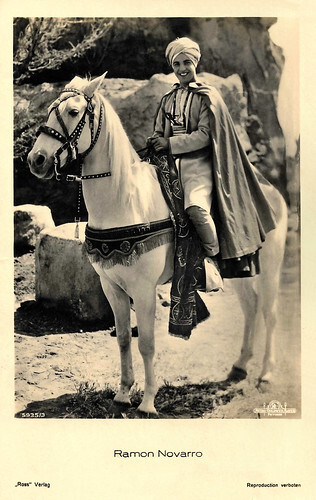
German postcard by Ross Verlag, no. 5935/3, 1930-1931. Photo: Metro Goldwyn Mayer. Ramon Novarro in Son of India (Jacques Feyder, 1931).
Mexican-American actor Ramon Novarro (1899-1968) was a popular Latin Lover of the 1920s and early 1930s. He was the star of silent Hollywood's biggest epic, Ben-Hur (Fred Niblo, 1925).
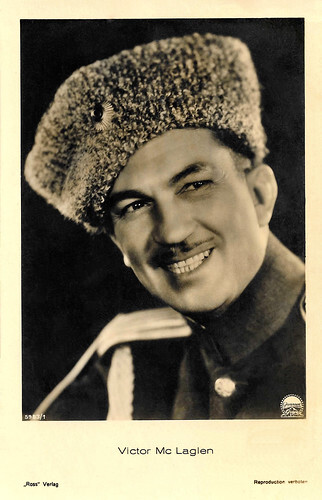
German postcard by Ross Verlag, no. 5983/1, 1930-1931. Photo: Paramount. Victor MacLaglen in Dishonored (Josef von Sternberg, 1931).
Victor McLaglen (1886-1959) was a Scottish boxer and World War I veteran who became a successful film actor. He started in British silent films and later became a popular character actor in Hollywood, with a particular knack for playing drunks.
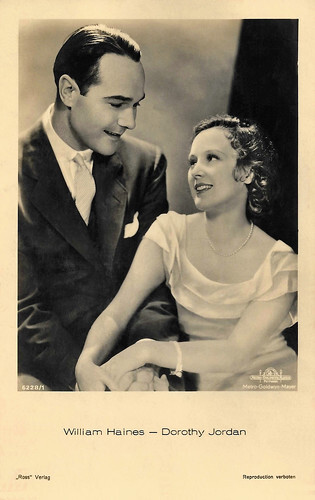
German postcard by Ross Verlag, no. 6228/1, 1931-1932. Photo: Metro Goldwyn Mayer.
William 'Billy' Haines (1900–1973) was an American film actor and interior designer. By the end of the silent era, he was regularly named as the no. 1 male box-office draw of Hollywood. Dorothy Jordan (1906-1988) was an American film actress who emerged as an actress at the start of the talkies. She made more than 20 films in four years, opposite Ramon Novarro, Clark Gable, Lionel Barrymore, Walter Huston and Jimmy Durante. In 1933, she married Merian C. Cooper and retired.
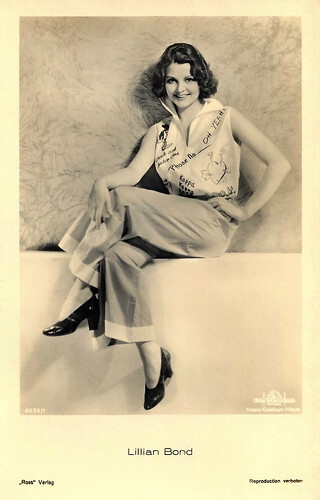
German postcard by Ross Verlag, no. 6238/1, 1931-1932. Photo: Metro Goldwyn Mayer.
Lovely British actress Lilian Bond (1908-1991) made over 50 films in Hollywood from the late 1920s through the 1940s. One of her first roles was in James Whale’s classic horror-comedy The Old Dark House (1932), but in later years she mostly appeared in B-movies, both in leading parts and in bit roles. Possibly her best-known film role was in the Western The Westerner (1940) starring Gary Cooper and Walter Brennan, in which she played Lillie Langtry.
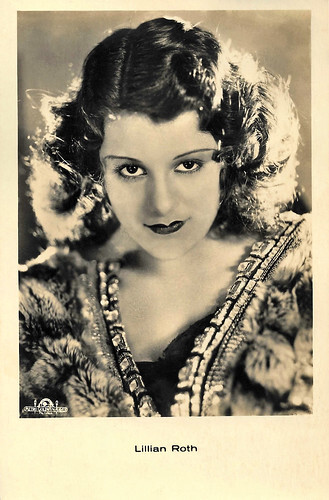
Austrian postcard by Iris Verlag, no. 6283. Photo: Metro-Goldwyn-Mayer. Lillian Roth in Madam Satan (Cecil B. DeMille, 1930).
American singer and actress Lillian Roth was a Broadway star and Hollywood actress. Among the films she made with Paramount were The Love Parade (1929) with Maurice Chevalier, The Vagabond King (1930), Cecil B. DeMille's Madam Satan (1930), and the Marx Brothers' second film, Animal Crackers (1930). She rebelled against the pressure of her domineering stage mother and reacted to the death of her fiancé by becoming an alcoholic. Her life story was told in the popular biopic I'll Cry Tomorrow (Daniel Mann, 1955) starring Susan Hayward.
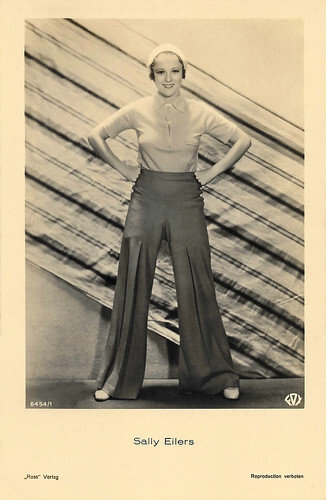
German postcard by Ross Verlag, no. 6454/1, 1931-1932. Photo: Fox.
American actress Sally Eilers (1908-1978) was a popular Hollywood star in the early 1930s. She was tagged 'the most beautiful girl in movies'.
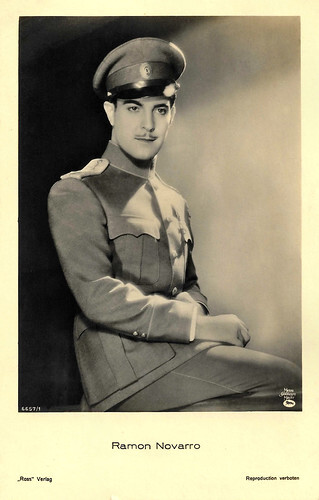
German postcard by Ross Verlag, no. 6657/1, 1931-1932. Photo: Metro Goldwyn Mayer. Ramon Novarro in Mata Hari (George Fitzmaurice, 1931).
Mexican-American actor Ramon Novarro (1899-1968) was a popular Latin Lover of the 1920s and early 1930s. He was the star of silent Hollywood's biggest epic, Ben-Hur (Fred Niblo, 1925).
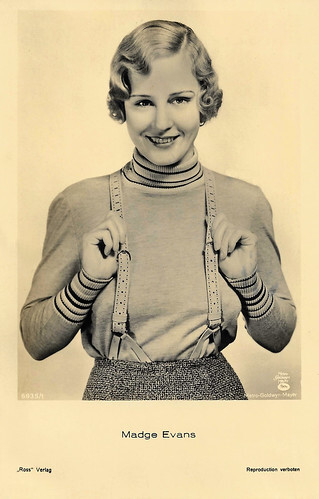
German postcard by Ross Verlag, no. 6935/1, 1931-1932. Photo: Metro-Goldwyn-Mayer.
Lovely Madge Evans (1909-1981) was an American stage and film actress who often played the 'nice' girl in Hollywood films of the 1930s. She began her career as a child performer and model, starting with Fairy Soap commercials at the age of two.
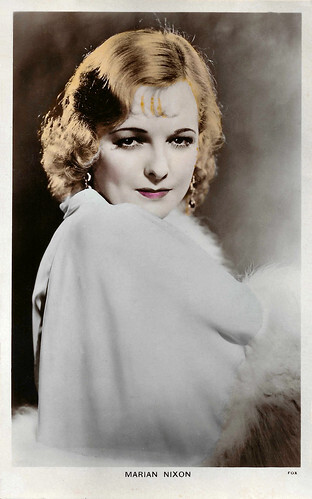
British postcard in the Colourgraph Series, London, no. C 42 a. Photo: Fox.
Marian Nixon (1904-1983), aka Marion Nixon, was an American actress who acted in over 70 films.
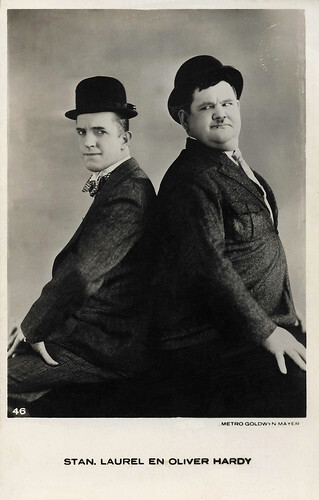
Dutch postcard, no. 46. Photo: Metro Goldwyn Mayer.
Thin Englishman Stan Laurel (1890–1965) and heavyset American Oliver Hardy (1892–1957) were a comedy double act during the early Classical Hollywood era. They became well known during the late 1920s through the mid-1940s for their slapstick comedy, with Laurel playing the clumsy and childlike friend of the pompous Hardy.
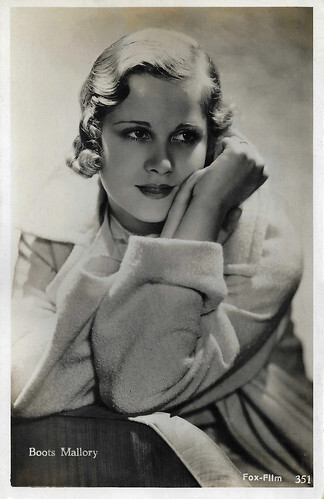
American actress Boots Mallory (1913-1958) started her career as a model and a Ziegfeld Girl. Her film career began in the era of early talkies, and she became a WAMPAS Baby Star in 1932.
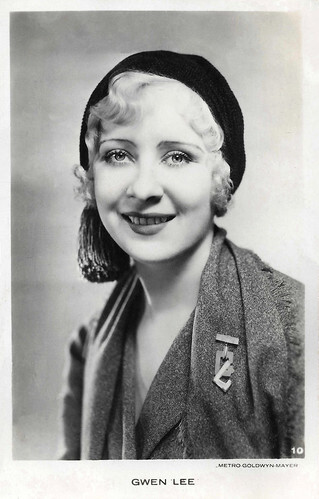
Dutch postcard, no. 10. Photo: Metro Goldwyn.
Blonde, blue-eyed and impeccably coiffured Gwen Lee (1904-1961) was one of the archetypical Flappers of the Jazz Age. The actress played supporting roles as dizzy blondes and gold-digging vamps in films of the late 1920s and early 1930s. Lee appeared in over 60 films and retired in 1938.
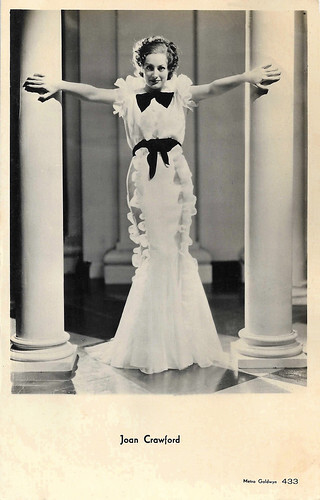
Dutch postcard, no. 433. Photo: Metro Goldwyn.
American film star Joan Crawford (1904-1977) had a career that spanned many decades, studios, and controversies. In her silent films, she made an impact as a vivacious Jazz Age flapper, and later, she matured into a star of psychological melodramas.
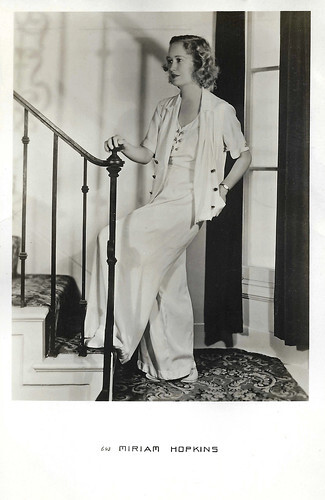
Dutch postcard, no. 643. Photo: Paramount.
After ten years on the stage as a successful actress, Miriam Hopkins (1902-1972) joined Paramount in 1930 and became one of Hollywood's top-ranking stars. She returned to the stage as her film career slowed in the 1940s. During the 1950s, she added television to her repertoire.
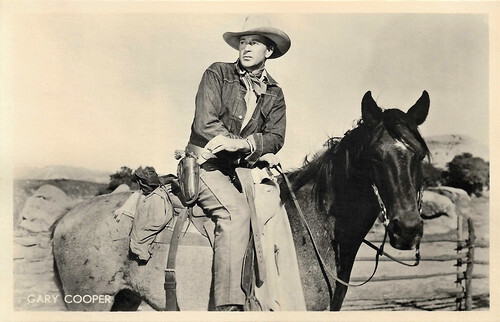
Dutch postcard, no. S. & v. H. A. Photo: M.P.E.A. Gary Cooper in Along Came Jones (Stuart Heisler, 1945).
American screen legend Gary Cooper (1901-1961) is well remembered for his stoic, understated acting style in more than one hundred Westerns, comedies and dramas. He received five Oscar nominations and won twice for his roles as Alvin York in Sergeant York (1941) and as Will Kane in High Noon (1952).
All postcards: Collection Geoffrey Donaldson Institute. To be continued on the 15th of next month.

German postcard by Ross Verlag, no. 5935/3, 1930-1931. Photo: Metro Goldwyn Mayer. Ramon Novarro in Son of India (Jacques Feyder, 1931).
Mexican-American actor Ramon Novarro (1899-1968) was a popular Latin Lover of the 1920s and early 1930s. He was the star of silent Hollywood's biggest epic, Ben-Hur (Fred Niblo, 1925).

German postcard by Ross Verlag, no. 5983/1, 1930-1931. Photo: Paramount. Victor MacLaglen in Dishonored (Josef von Sternberg, 1931).
Victor McLaglen (1886-1959) was a Scottish boxer and World War I veteran who became a successful film actor. He started in British silent films and later became a popular character actor in Hollywood, with a particular knack for playing drunks.

German postcard by Ross Verlag, no. 6228/1, 1931-1932. Photo: Metro Goldwyn Mayer.
William 'Billy' Haines (1900–1973) was an American film actor and interior designer. By the end of the silent era, he was regularly named as the no. 1 male box-office draw of Hollywood. Dorothy Jordan (1906-1988) was an American film actress who emerged as an actress at the start of the talkies. She made more than 20 films in four years, opposite Ramon Novarro, Clark Gable, Lionel Barrymore, Walter Huston and Jimmy Durante. In 1933, she married Merian C. Cooper and retired.

German postcard by Ross Verlag, no. 6238/1, 1931-1932. Photo: Metro Goldwyn Mayer.
Lovely British actress Lilian Bond (1908-1991) made over 50 films in Hollywood from the late 1920s through the 1940s. One of her first roles was in James Whale’s classic horror-comedy The Old Dark House (1932), but in later years she mostly appeared in B-movies, both in leading parts and in bit roles. Possibly her best-known film role was in the Western The Westerner (1940) starring Gary Cooper and Walter Brennan, in which she played Lillie Langtry.

Austrian postcard by Iris Verlag, no. 6283. Photo: Metro-Goldwyn-Mayer. Lillian Roth in Madam Satan (Cecil B. DeMille, 1930).
American singer and actress Lillian Roth was a Broadway star and Hollywood actress. Among the films she made with Paramount were The Love Parade (1929) with Maurice Chevalier, The Vagabond King (1930), Cecil B. DeMille's Madam Satan (1930), and the Marx Brothers' second film, Animal Crackers (1930). She rebelled against the pressure of her domineering stage mother and reacted to the death of her fiancé by becoming an alcoholic. Her life story was told in the popular biopic I'll Cry Tomorrow (Daniel Mann, 1955) starring Susan Hayward.

German postcard by Ross Verlag, no. 6454/1, 1931-1932. Photo: Fox.
American actress Sally Eilers (1908-1978) was a popular Hollywood star in the early 1930s. She was tagged 'the most beautiful girl in movies'.

German postcard by Ross Verlag, no. 6657/1, 1931-1932. Photo: Metro Goldwyn Mayer. Ramon Novarro in Mata Hari (George Fitzmaurice, 1931).
Mexican-American actor Ramon Novarro (1899-1968) was a popular Latin Lover of the 1920s and early 1930s. He was the star of silent Hollywood's biggest epic, Ben-Hur (Fred Niblo, 1925).

German postcard by Ross Verlag, no. 6935/1, 1931-1932. Photo: Metro-Goldwyn-Mayer.
Lovely Madge Evans (1909-1981) was an American stage and film actress who often played the 'nice' girl in Hollywood films of the 1930s. She began her career as a child performer and model, starting with Fairy Soap commercials at the age of two.

British postcard in the Colourgraph Series, London, no. C 42 a. Photo: Fox.
Marian Nixon (1904-1983), aka Marion Nixon, was an American actress who acted in over 70 films.

Dutch postcard, no. 46. Photo: Metro Goldwyn Mayer.
Thin Englishman Stan Laurel (1890–1965) and heavyset American Oliver Hardy (1892–1957) were a comedy double act during the early Classical Hollywood era. They became well known during the late 1920s through the mid-1940s for their slapstick comedy, with Laurel playing the clumsy and childlike friend of the pompous Hardy.

American actress Boots Mallory (1913-1958) started her career as a model and a Ziegfeld Girl. Her film career began in the era of early talkies, and she became a WAMPAS Baby Star in 1932.

Dutch postcard, no. 10. Photo: Metro Goldwyn.
Blonde, blue-eyed and impeccably coiffured Gwen Lee (1904-1961) was one of the archetypical Flappers of the Jazz Age. The actress played supporting roles as dizzy blondes and gold-digging vamps in films of the late 1920s and early 1930s. Lee appeared in over 60 films and retired in 1938.

Dutch postcard, no. 433. Photo: Metro Goldwyn.
American film star Joan Crawford (1904-1977) had a career that spanned many decades, studios, and controversies. In her silent films, she made an impact as a vivacious Jazz Age flapper, and later, she matured into a star of psychological melodramas.

Dutch postcard, no. 643. Photo: Paramount.
After ten years on the stage as a successful actress, Miriam Hopkins (1902-1972) joined Paramount in 1930 and became one of Hollywood's top-ranking stars. She returned to the stage as her film career slowed in the 1940s. During the 1950s, she added television to her repertoire.

Dutch postcard, no. S. & v. H. A. Photo: M.P.E.A. Gary Cooper in Along Came Jones (Stuart Heisler, 1945).
American screen legend Gary Cooper (1901-1961) is well remembered for his stoic, understated acting style in more than one hundred Westerns, comedies and dramas. He received five Oscar nominations and won twice for his roles as Alvin York in Sergeant York (1941) and as Will Kane in High Noon (1952).
All postcards: Collection Geoffrey Donaldson Institute. To be continued on the 15th of next month.
Published on May 14, 2025 22:00
May 13, 2025
Directed by Ewald André Dupont
German film director Ewald André Dupont (1891-1956) was an influential critic and newspaper columnist before he beccame one of the pioneers of the German silent film. After several successes in Germany, he worked in London and in Hollywood. He was unable to continue his star status into the sound era. In Hollywood, he worked mainly as a writer and director for B-movies and television series.
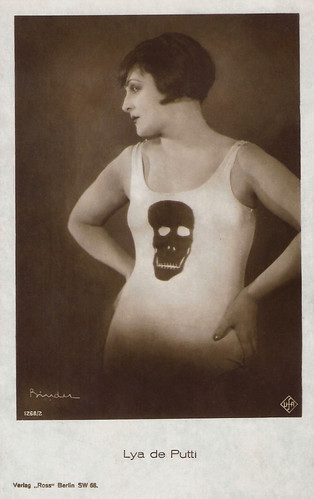
German postcard by Ross Verlag, no. 1268/2, 1927-1928. Photo: Ufa. Lya de Putti in Varieté (Ewald André Dupont, 1925). As Bertha-Marie, she seduces and betrays the simple trapeze artist Stephan Huller ( Emil Jannings ) and drives him to kill his partner.
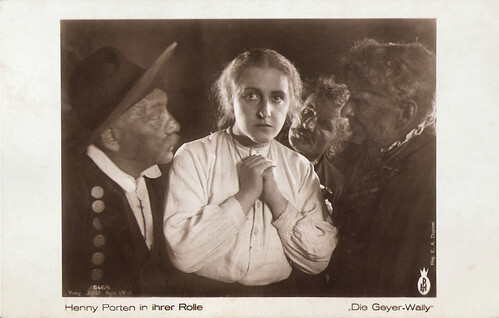
German postcard by Ross Verlag, no. 646/5. Photo: E.A. Dupont / HPF (Henny Porten Film). Henny Porten in Die Geier-Wally / Wally of the Vultures (E.A. Dupont, 1921), based on the novel by Wilhelmine von Hillern.
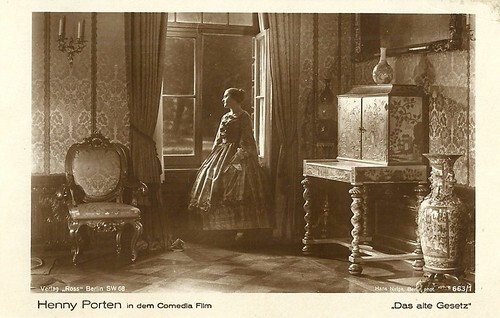
German postcard by Ross Verlag, no. 663/1. Photo: Hans Natge, Berlin / Comedia Film. Henny Porten in Das alte Gesetz (E.A. Dupont, 1923).
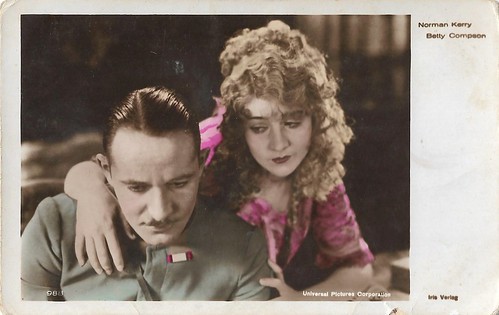
Austrian postcard by Iris Verlag, no. 988. Photo: Universal Pictures Corporation. Betty Compson and Norman Kerry in Love Me and the World Is Mine (Ewald André Dupont, 1927).
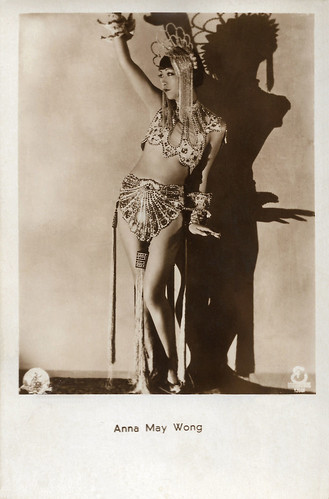
Austrian postcard by Iris-Verlag, no. 5853. Photo: British International Pictures (BIP). Anna May Wong in Piccadilly (Ewald André Dupont, 1929). Gilda Gray was the top-billed actress in Piccadilly, but Variety commented that Wong "outshines the star" and that "from the moment Miss Wong dances in the kitchen's rear, she steals 'Piccadilly' from Miss Gray."
A respected exponent of the German expressionist movement
Ewald André Dupont was born in 1891 in Zeitz in the Province of Saxony in the German Empire. He was often credited as E. A. Dupont. He was the son of journalists Hedwig Friedlander and Hermann DuPont. Dupont was raised in Berlin. where his father was the editor-in-chief of the Berliner Illustrirte Zeitung.
After briefly attending the University of Berlin, Dupont became editor of the Berliner Morgenpost in 1911. In 1915, he established the regular column 'Kino und Varieté' (Film and Variety) in the Berlin newspaper B.Z. am Mittag. Eventually, he became the editor of the Berliner Allgemeinen Zeitung.
As he was friends with various people from the film industry, he turned to cinema. In 1916, he started to write scripts for detective films and also worked as a story editor for Richard Oswald . His first screenplay was for the Harry Higgs detective film Mein ist die Rache / Vengeance is Mine (Rudolf Meinert, 1916) with Hans Mierendorff as Harry Higgs. Within a year, he had had 11 of his scripts turned into films. In 1917 and 1918, eleven of his scripts were filmed by the directors Joe May (Joe Deebs series), Rudolf Meinert (Harry Higgs series) and Richard Oswald (3 parts of the Aufklärungs series Es werde Licht! / Let there be light!). In 1918, Dupont started as a member of the editorial staff of the film magazine Der Film. He was considered an important film journalist in Germany in the 1910s.
In 1918, he was hired by Stern-Film-GmbH as an author and director for the twelve-part detective serial Europa, postlagernd / Europe Mail Storage (1918) with Max Landa . Up to that time, he reportedly had never been inside a film studio. After Alhohol / Alcohol (Ewald André Dupont, Alfred Lind, 1920), Dupont went to Gloria-Film, where he made a series of popular cult films. He worked with Paul Leni on Patience (Felix Basch, Paul Leni, 1920), Der weisse Pfau / The White Peacock (Ewald André Dupont, 1920) and the two-part film Kinder der Finsternis / Children of Darkness Ewald André Dupont, 1921) with Grit Hegesa . Dupont became a respected exponent of the German expressionist movement. He gained widespread recognition with the Henny Porten films Die Geier-Wally / Wally of the Vultures (1921) and Das alte Gesetz (1923).
In 1924, Dupont ran a variety theatre in Mannheim for a season, a milieu that he repeatedly depicted in his films. One of his greatest successes was Varieté / Variety (1925) for Ufa producer Erich Pommer and with Emil Jannings and Lya de Putti . This film, about an ex-trapeze artist, was noted for its innovative camerawork with highly expressive movement through space, accomplished by the expressionist cinematographer Karl Freund. The jealousy drama set in a circus milieu became a worldwide success. Varieté / Variety even did well in the United States, screening for 12 weeks at New York's Rialto Theatre.
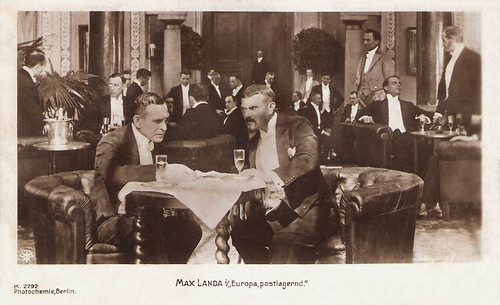
German postcard by Photochemie, Berlin, no. K. 2292. Photo: Stern-Film. Max Landa as the cosmopolitan gentleman-detective Joe Deebs in Europa, postlagernd / Europe Mail Storage (Ewald André Dupont, 1918).
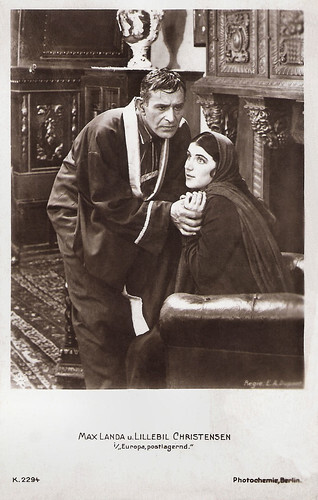
German postcard by Photochemie, Berlin, no. K. 2294. Photo: Stern-Film. Max Landa and Lillebil Christensen in Europa, postlagernd / Europe Mail Storage (Ewald André Dupont, 1918).
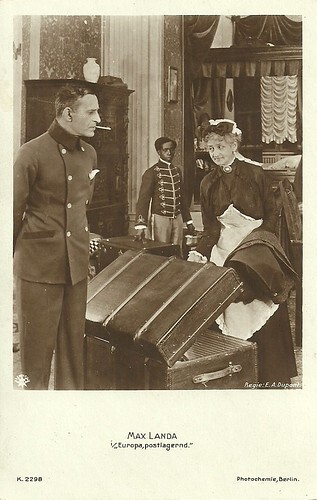
German postcard by Photochemie, Berlin, no. K. 2298. Photo: Stern-Film. Max Landa as detective Joe Deebs in Europa, postlagernd / Europe Mail Storage (Ewald André Dupont, 1918).
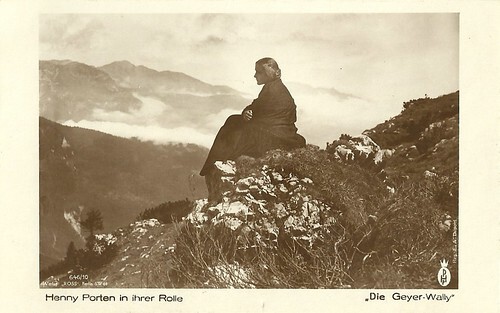
German postcard by Ross Verlag, no. 646/1. Photo: HPF (Henny Porten Film). Henny Porten as Wally in Die Geier-Wally / Wally of the Vultures (E.A. Dupont, 1921), based on the novel by Wilhelmine von Hillern. Sets were by Paul Leni.
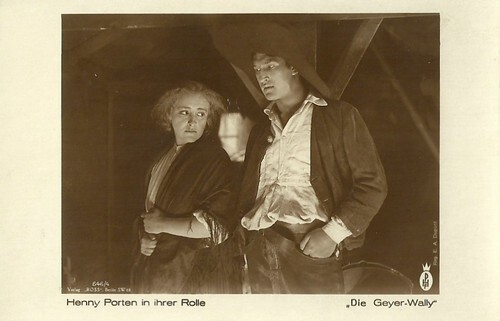
German postcard by Ross Verlag, no. 646/4. Photo: Henny Porten-Film. Henny Porten and Wilhelm Dieterle in Die Geier-Wally / Wally of the Vultures (E.A. Dupont, 1921).
Demonstrating his visual flair with two prestige productions
Ewald André Dupont's success was noticed by Carl Laemmle at Universal, who offered Dupont a lucrative contract. Dupont left Decla-Bioskop and joined Universal. His first Hollywood project was Love Me and the World Is Mine in the early summer of 1926, which ran well over budget ($350,000) and was not a success. He could not put up with the working conditions in Hollywood and broke his contract.
I.S. Mowis at IMDb : "Crossing the Atlantic again, he signed with British National Pictures in 1928. He briefly became their leading director, again demonstrating his visual flair with two prestige productions". His first film for British Mational Pictures was Moulin Rouge (1928), shot in Paris and London and starring Olga Tschechova . It was an international success, thanks to some scenes considered scandalous. The other success was the late silent film Piccadilly (1929), which is remembered for the central performance of the Chinese-American actress Anna May Wong . It was BIP's most expensively made picture up to this time.
In Great Britain, Dupont was involved in setting up the new sound film production in Elstree. He made early sound films in various language versions until 1931. His first multiple-language sound film in London was the film drama Atlantik / Atlantic (1929), a retelling of the Titanic disaster shot in both English and German. It was celebrated in Germany as the ‘first German one hundred per cent talking film’. It was one of the most innovative uses of sound film technology available at the time, but the production was an expensive flop, due mainly to poor dialogue and stilted performances. Hans Michael Bock at Filmportal : "With his next films - Two Worlds (1930), a tragic love story between a Jewish girl and an Austrian officer during the First World War, and the claustrophobic lighthouse drama Cape Forlorn (1931) - each of which was produced in three language versions, Dupont became an exponent of this important production technique during the transition to sound film."
In 1933, the Jewish director emigrated to the United States. His last films in Germany were the circus film Salto Mortale (1931) and the sports film Der Läufer von Marathon / The Runner from Marathon (1933), made during the Olympic Games in Los Angeles. The latter became Dupont's springboard to a new Hollywood engagement. After 1933, he worked at different times for Universal, Paramount and Warner Brothers. Critical success proved elusive, as almost all of his assignments were B movies and low budget "programmers". He was no longer able to build on his earlier successes and was considered in the American film industry as 'difficult'. On the set of Hell's Kitchen (1939) with the East Side Kids, he slapped a junior member of the cast who had mocked his accent. Dupont was fired and replaced by Lewis Seiler. Unhappy with the lack of opportunities afforded him in Hollywood, Dupont worked from then on as a publicist and also ran an agency for film talent.
Ten years later, he returned to filmmaking when he wrote and directed the offbeat minor Film Noir The Scarf (1951) starring John Ireland and Mercedes McCambridge. After his comeback film was also a flop, Dupont wrote 23 episodes for Big Town (1950–1956), a crime series set in the press milieu, and directed two of those episodes, Tape Recorder (1952) and The Story of Jerry Baxter (1953). He directed several more low-budget films, such as the low-grade Horror film The Neanderthal Man (1953), which I.S. Mowis describes as a "notorious sci-fi stinker". The end of his career came when he was fired from Miss Robin Crusoe (Eugene Frenke, 1953) for showing up drunk once too often. Finally, he was involved in the screenplay for William Dieterle 's film biography of Richard Wagner, Magic Fire (William Dieterle, 1956). Shortly before his 65th birthday in 1956, Ewald André Dupont died in Hollywood as a result of cancer. He was married to the actress Gretl Dupont.
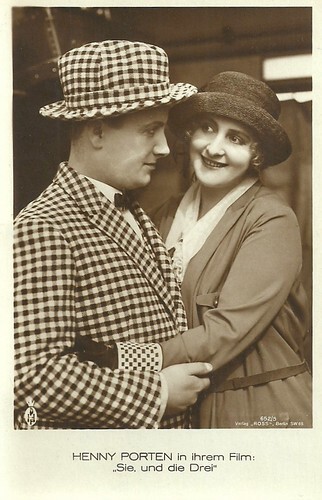
German postcard by Ross Verlag, no. 652/5. Photo: Henny Porten Film. Henny Porten and Hermann Thimig in the German silent comedy Sie und die Drei (E.A. Dupont, 1922).
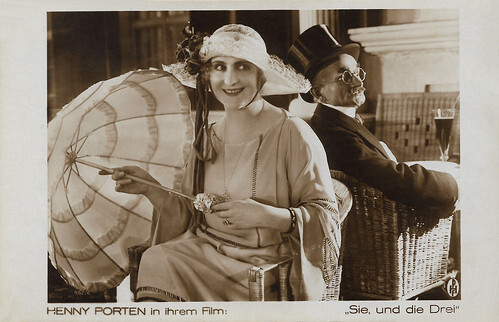
German postcard by Ross Verlag, no. 652/6. Photo: Henny Porten-Film. Henny Porten in the German silent comedy Sie, und die Drei (E.A. Dupont, 1922).

German postcard by Ross Verlag, no. 663/2. Photo: Hans Natge, Berlin / Comedia Film. Henny Porten and Ernst Deutsch in Das alte Gesetz (E.A. Dupont, 1923).
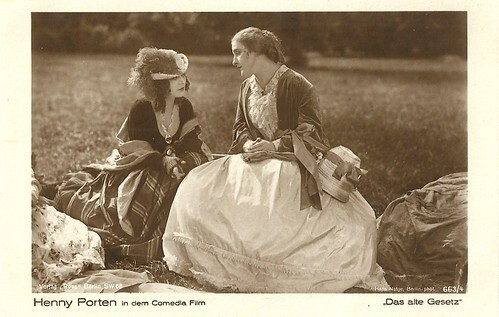
German postcard by Ross Verlag, no. 663/4. Photo: Hans Natge, Berlin / Comedia Film. Henny Porten in Das alte Gesetz (E.A. Dupont, 1923).
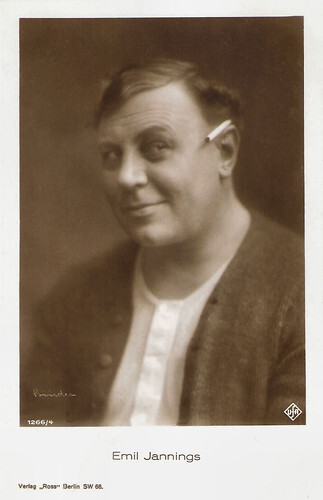
German postcard by Ross Verlag, no. 1266/4, 1927-1928. Photo: Alex Binder / Ufa. Emil Jannings in Varieté / Variety (E.A. Dupont, 1925).
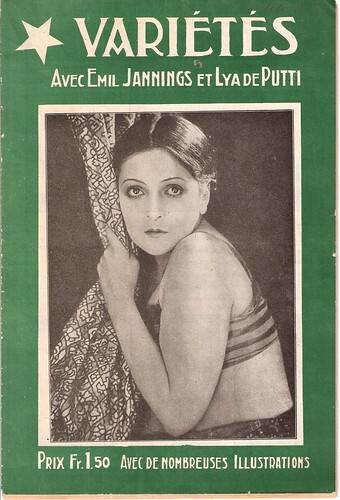
Belgian brochure by Patria editions, Antwerp. On the cover is Lya de Putti in Varieté / Variety (Ewald André Dupont, 1925).

Austrian postcard by Iris Verlag, no. 988. Photo: Universal Pictures Corporations. Norman Kerry and Betty Compson in Love Me and the World Is Mine (Ewald André Dupont, 1927).
Sources: Hans Michael Bock (Filmportal - German), (IMDb), Wikipedia (French, German and English), and .

German postcard by Ross Verlag, no. 1268/2, 1927-1928. Photo: Ufa. Lya de Putti in Varieté (Ewald André Dupont, 1925). As Bertha-Marie, she seduces and betrays the simple trapeze artist Stephan Huller ( Emil Jannings ) and drives him to kill his partner.

German postcard by Ross Verlag, no. 646/5. Photo: E.A. Dupont / HPF (Henny Porten Film). Henny Porten in Die Geier-Wally / Wally of the Vultures (E.A. Dupont, 1921), based on the novel by Wilhelmine von Hillern.

German postcard by Ross Verlag, no. 663/1. Photo: Hans Natge, Berlin / Comedia Film. Henny Porten in Das alte Gesetz (E.A. Dupont, 1923).

Austrian postcard by Iris Verlag, no. 988. Photo: Universal Pictures Corporation. Betty Compson and Norman Kerry in Love Me and the World Is Mine (Ewald André Dupont, 1927).

Austrian postcard by Iris-Verlag, no. 5853. Photo: British International Pictures (BIP). Anna May Wong in Piccadilly (Ewald André Dupont, 1929). Gilda Gray was the top-billed actress in Piccadilly, but Variety commented that Wong "outshines the star" and that "from the moment Miss Wong dances in the kitchen's rear, she steals 'Piccadilly' from Miss Gray."
A respected exponent of the German expressionist movement
Ewald André Dupont was born in 1891 in Zeitz in the Province of Saxony in the German Empire. He was often credited as E. A. Dupont. He was the son of journalists Hedwig Friedlander and Hermann DuPont. Dupont was raised in Berlin. where his father was the editor-in-chief of the Berliner Illustrirte Zeitung.
After briefly attending the University of Berlin, Dupont became editor of the Berliner Morgenpost in 1911. In 1915, he established the regular column 'Kino und Varieté' (Film and Variety) in the Berlin newspaper B.Z. am Mittag. Eventually, he became the editor of the Berliner Allgemeinen Zeitung.
As he was friends with various people from the film industry, he turned to cinema. In 1916, he started to write scripts for detective films and also worked as a story editor for Richard Oswald . His first screenplay was for the Harry Higgs detective film Mein ist die Rache / Vengeance is Mine (Rudolf Meinert, 1916) with Hans Mierendorff as Harry Higgs. Within a year, he had had 11 of his scripts turned into films. In 1917 and 1918, eleven of his scripts were filmed by the directors Joe May (Joe Deebs series), Rudolf Meinert (Harry Higgs series) and Richard Oswald (3 parts of the Aufklärungs series Es werde Licht! / Let there be light!). In 1918, Dupont started as a member of the editorial staff of the film magazine Der Film. He was considered an important film journalist in Germany in the 1910s.
In 1918, he was hired by Stern-Film-GmbH as an author and director for the twelve-part detective serial Europa, postlagernd / Europe Mail Storage (1918) with Max Landa . Up to that time, he reportedly had never been inside a film studio. After Alhohol / Alcohol (Ewald André Dupont, Alfred Lind, 1920), Dupont went to Gloria-Film, where he made a series of popular cult films. He worked with Paul Leni on Patience (Felix Basch, Paul Leni, 1920), Der weisse Pfau / The White Peacock (Ewald André Dupont, 1920) and the two-part film Kinder der Finsternis / Children of Darkness Ewald André Dupont, 1921) with Grit Hegesa . Dupont became a respected exponent of the German expressionist movement. He gained widespread recognition with the Henny Porten films Die Geier-Wally / Wally of the Vultures (1921) and Das alte Gesetz (1923).
In 1924, Dupont ran a variety theatre in Mannheim for a season, a milieu that he repeatedly depicted in his films. One of his greatest successes was Varieté / Variety (1925) for Ufa producer Erich Pommer and with Emil Jannings and Lya de Putti . This film, about an ex-trapeze artist, was noted for its innovative camerawork with highly expressive movement through space, accomplished by the expressionist cinematographer Karl Freund. The jealousy drama set in a circus milieu became a worldwide success. Varieté / Variety even did well in the United States, screening for 12 weeks at New York's Rialto Theatre.

German postcard by Photochemie, Berlin, no. K. 2292. Photo: Stern-Film. Max Landa as the cosmopolitan gentleman-detective Joe Deebs in Europa, postlagernd / Europe Mail Storage (Ewald André Dupont, 1918).

German postcard by Photochemie, Berlin, no. K. 2294. Photo: Stern-Film. Max Landa and Lillebil Christensen in Europa, postlagernd / Europe Mail Storage (Ewald André Dupont, 1918).

German postcard by Photochemie, Berlin, no. K. 2298. Photo: Stern-Film. Max Landa as detective Joe Deebs in Europa, postlagernd / Europe Mail Storage (Ewald André Dupont, 1918).

German postcard by Ross Verlag, no. 646/1. Photo: HPF (Henny Porten Film). Henny Porten as Wally in Die Geier-Wally / Wally of the Vultures (E.A. Dupont, 1921), based on the novel by Wilhelmine von Hillern. Sets were by Paul Leni.

German postcard by Ross Verlag, no. 646/4. Photo: Henny Porten-Film. Henny Porten and Wilhelm Dieterle in Die Geier-Wally / Wally of the Vultures (E.A. Dupont, 1921).
Demonstrating his visual flair with two prestige productions
Ewald André Dupont's success was noticed by Carl Laemmle at Universal, who offered Dupont a lucrative contract. Dupont left Decla-Bioskop and joined Universal. His first Hollywood project was Love Me and the World Is Mine in the early summer of 1926, which ran well over budget ($350,000) and was not a success. He could not put up with the working conditions in Hollywood and broke his contract.
I.S. Mowis at IMDb : "Crossing the Atlantic again, he signed with British National Pictures in 1928. He briefly became their leading director, again demonstrating his visual flair with two prestige productions". His first film for British Mational Pictures was Moulin Rouge (1928), shot in Paris and London and starring Olga Tschechova . It was an international success, thanks to some scenes considered scandalous. The other success was the late silent film Piccadilly (1929), which is remembered for the central performance of the Chinese-American actress Anna May Wong . It was BIP's most expensively made picture up to this time.
In Great Britain, Dupont was involved in setting up the new sound film production in Elstree. He made early sound films in various language versions until 1931. His first multiple-language sound film in London was the film drama Atlantik / Atlantic (1929), a retelling of the Titanic disaster shot in both English and German. It was celebrated in Germany as the ‘first German one hundred per cent talking film’. It was one of the most innovative uses of sound film technology available at the time, but the production was an expensive flop, due mainly to poor dialogue and stilted performances. Hans Michael Bock at Filmportal : "With his next films - Two Worlds (1930), a tragic love story between a Jewish girl and an Austrian officer during the First World War, and the claustrophobic lighthouse drama Cape Forlorn (1931) - each of which was produced in three language versions, Dupont became an exponent of this important production technique during the transition to sound film."
In 1933, the Jewish director emigrated to the United States. His last films in Germany were the circus film Salto Mortale (1931) and the sports film Der Läufer von Marathon / The Runner from Marathon (1933), made during the Olympic Games in Los Angeles. The latter became Dupont's springboard to a new Hollywood engagement. After 1933, he worked at different times for Universal, Paramount and Warner Brothers. Critical success proved elusive, as almost all of his assignments were B movies and low budget "programmers". He was no longer able to build on his earlier successes and was considered in the American film industry as 'difficult'. On the set of Hell's Kitchen (1939) with the East Side Kids, he slapped a junior member of the cast who had mocked his accent. Dupont was fired and replaced by Lewis Seiler. Unhappy with the lack of opportunities afforded him in Hollywood, Dupont worked from then on as a publicist and also ran an agency for film talent.
Ten years later, he returned to filmmaking when he wrote and directed the offbeat minor Film Noir The Scarf (1951) starring John Ireland and Mercedes McCambridge. After his comeback film was also a flop, Dupont wrote 23 episodes for Big Town (1950–1956), a crime series set in the press milieu, and directed two of those episodes, Tape Recorder (1952) and The Story of Jerry Baxter (1953). He directed several more low-budget films, such as the low-grade Horror film The Neanderthal Man (1953), which I.S. Mowis describes as a "notorious sci-fi stinker". The end of his career came when he was fired from Miss Robin Crusoe (Eugene Frenke, 1953) for showing up drunk once too often. Finally, he was involved in the screenplay for William Dieterle 's film biography of Richard Wagner, Magic Fire (William Dieterle, 1956). Shortly before his 65th birthday in 1956, Ewald André Dupont died in Hollywood as a result of cancer. He was married to the actress Gretl Dupont.

German postcard by Ross Verlag, no. 652/5. Photo: Henny Porten Film. Henny Porten and Hermann Thimig in the German silent comedy Sie und die Drei (E.A. Dupont, 1922).

German postcard by Ross Verlag, no. 652/6. Photo: Henny Porten-Film. Henny Porten in the German silent comedy Sie, und die Drei (E.A. Dupont, 1922).

German postcard by Ross Verlag, no. 663/2. Photo: Hans Natge, Berlin / Comedia Film. Henny Porten and Ernst Deutsch in Das alte Gesetz (E.A. Dupont, 1923).

German postcard by Ross Verlag, no. 663/4. Photo: Hans Natge, Berlin / Comedia Film. Henny Porten in Das alte Gesetz (E.A. Dupont, 1923).

German postcard by Ross Verlag, no. 1266/4, 1927-1928. Photo: Alex Binder / Ufa. Emil Jannings in Varieté / Variety (E.A. Dupont, 1925).

Belgian brochure by Patria editions, Antwerp. On the cover is Lya de Putti in Varieté / Variety (Ewald André Dupont, 1925).

Austrian postcard by Iris Verlag, no. 988. Photo: Universal Pictures Corporations. Norman Kerry and Betty Compson in Love Me and the World Is Mine (Ewald André Dupont, 1927).
Sources: Hans Michael Bock (Filmportal - German), (IMDb), Wikipedia (French, German and English), and .
Published on May 13, 2025 22:00
May 12, 2025
Theo Lingen
German-Austrian comedian, director and author Theo Lingen (1903-1978) enjoyed for decades huge popularity as the devoted servant or bureaucratic dignitary in films. From 1933 on, the nasally-voiced Lingen solely played comedic roles and specialized in squeamish characters who tried to preserve decorum even if the situation was completely hopeless. He starred alongside Hans Moser in 24 films and often worked with directors E.W. Emo and Geza von Bolvary with whom he collaborated until the 1950s. The German and Austrian comedy isn’t imaginable without this brilliant character actor.
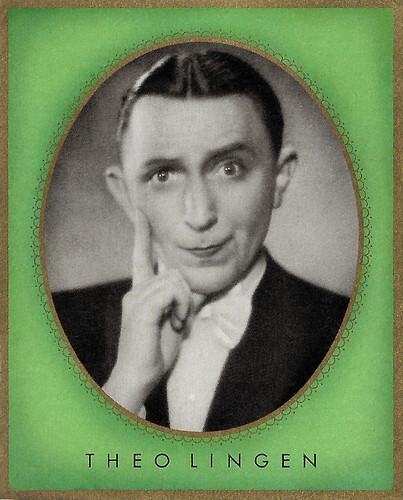
German collector card by Ross Verlag in the Bunte Filmbilder series for Martin Brinkmann A.G., Bremen, no. 53. Photo: Projektograph-Film. Theo Lingen in Wer zuletzt küßt… / Who kisses last... (E.W. Emo, 1936).
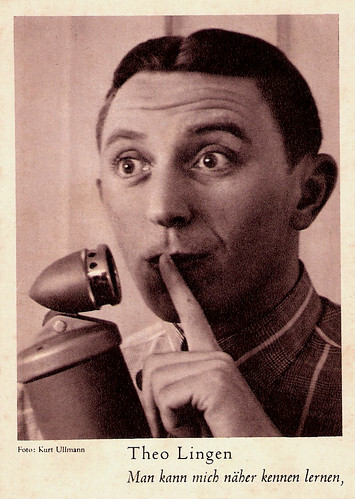
German collector card by Deutscher Verlag, Berlin, presented by Der Stern. Retail price: 10 Pfennig. Photo: Kurt Ullmann. Caption: Mann kann mich näher kennen lernen (Man can know more about me).
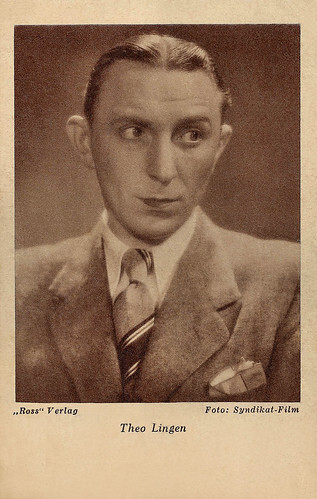
German postcard by Ross Verlag for Das Programm von Heute, Berlin. Photo: Syndikat-Film.
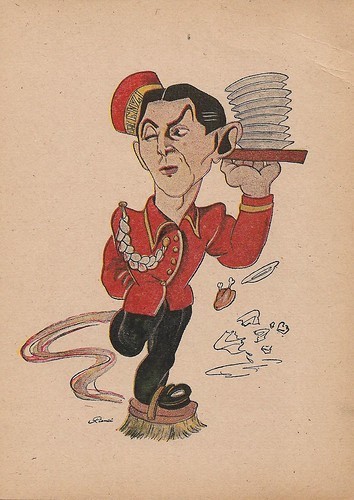
German postcard. Caricature drawing by Eberhard Renziehausen (Rienzi).
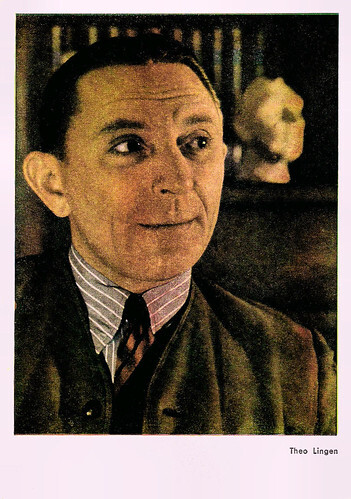
German postcard by Verlag und Druckerei Erwin Preuss, Dresden-Freital, Serie I Die neue farbige Filmstarkarte, no. 12. Photo: Charlott Serda.
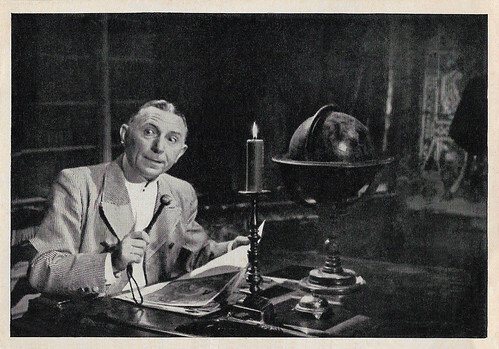
German collector card. Theo Lingen in Heidi (Luigi Comencini, 1952).
Friendly villains
Theo Lingen was born Franz Theodor Schmitz in 1903 in Hanover, Germany. He attended the Royal Goethe Gymnasium – now Goethe School – in Hanover but left before taking the Abitur (final exams). His theatrical talent was discovered during rehearsals for a school performance.
Beginning his professional stage career at the Boulevardtheater Schauburg in Hannover in 1921, the 19-year-old actor adopted as a stage name his middle name together with that of the birthplace of his father, Lingen in the Emsland region of Germany. In the following years he played among others at the Stadttheater Münster, at the Neues Theater in Frankfurt and from 1931 at different places in Berlin. He didn't confine to acting but he also wrote theatre plays which he directed himself.
The film called him up in 1930. He appeared in over 230 films till 1978 and directed 21 films between 1936 and 1960. He played non-comic characters – and sometimes danced - in such musicals as Dolly macht Karriere/Dolly's Way to Stardom (Anatole Litvak, 1930) starring Dolly Haas , and Das Flötenkonzert von Sanssouci/The Flute Concert of Sans-Souci (Gustav Ucicky, 1930) and played friendly villains in the classics M (Fritz Lang, 1931) starring Peter Lorre and Das Testament des Dr. Mabuse/Dr. Mabuses Testament (Fritz Lang, 1933).
The funny effect which his performance had on the public, wasn't to be missed. From 1933 on comedy was his domain and the Austrian comic Hans Moser became his partner in 24 films.
Together they made a contrasting pair in such popular entertainment films as the operetta Rosen in Tirol/The Bird Seller (Géza von Bolváry, 1940), Wiener Blut/Vienna Blood (Willi Forst, 1942) starring Willy Fritsch , and the comedy Schäm' dich, Brigitte!/Shame on You, Brigitte! (E.W. Emo, 1952) with Heinz Rühmann .
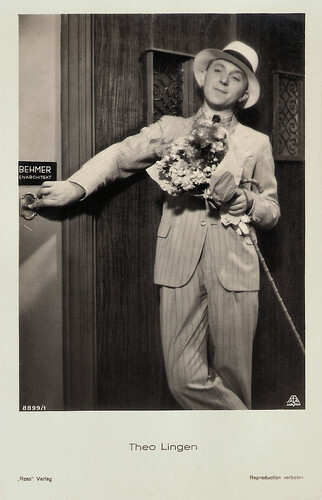
German postcard by Ross Verlag, no. 8899/1, 1933-1934. Photo: Aafa-Film.
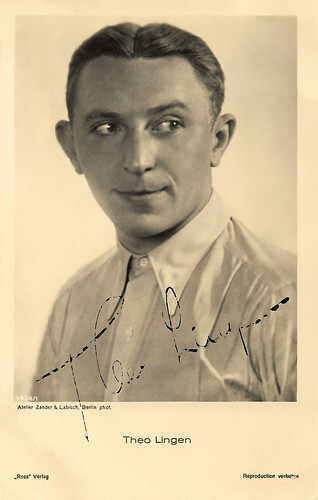
German postcard by Ross Verlag, no. 9424/1, 1935-1936. Photo: Zander & Labisch, Berlin.
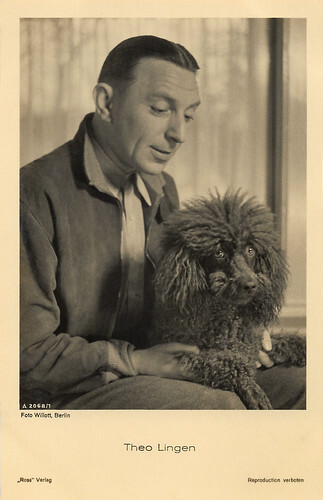
German postcard by Ross Verlag, no. A 2068/7, 1939-1940. Photo: Willott, Berlin.
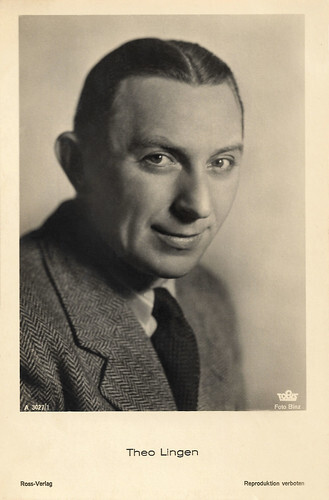
German postcard by Ross Verlag, no. A 3027/1, 1941-1944. Photo: Binz / Tobis.
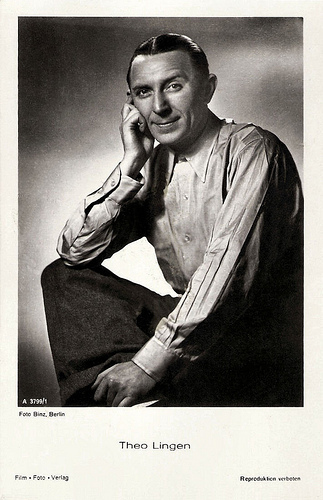
German Postcard by Film Foto Verlag, no. A 3799/1, 1941-1944. Photo: Foto Binz, Berlin.
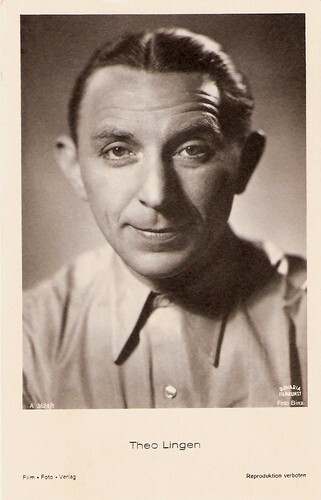
German postcard by Film Foto Verlag, no. A 3624/1, 1941-1944. Photo: Binz / Bavaria Filmkunst.
Special permission
From 1929 on, Theo Lingenperformed in Berlin, for instance as Macheath in Bertold Brecht's 'Dreigroschenoper'(The Threepenny Opera) at the Theater am Schiffbauerdamm, and in avantgarde plays, but also in cabaret and revue programmes at the Kurfürstendamm.
In February 1928, his daughter, Ursula, was born to Brecht's then-wife, singer Marianne Zoff. Brecht and Zoff divorced in September. Lingen and Zoff married later the same year and also raised Zoff's elder daughter Hanne. Conditions worsened after the 'Machtergreifung' of 30 January 1933. Zoff was half Jewish, which under the Nazi regime usually resulted in a 'Berufsverbot' (professional ban). Lingen thought about going into exile, but because of his great popularity with the general public Josef Goebbels gave him special permission to continue to perform and was able to protect his wife from persecution.
In 1936, Gustaf Gründgens brought him to the Preußische Staatstheater (the Berlin Prussian State Theatre), where Lingen stayed until 1944. During these years, he started to write his own plays. In most cases, Theo Lingen also directed the plays and played the leading role. Later, Lingen also wrote librettos for operas and operettas.
Lingen directed his first, short films in 1936, the four-part series of Till Eulenspiegel. From 1939 to 1956, he directed 18 feature films, including a buoyant film version of Paul Lincke's operetta Frau Luna/Mistress Moon (1941) with Lizzi Waldmüller , and Liebeskomödie/Comedy of Love (1942) with Magda Schneider .
Till the end of the war he acted in such popular comedies as Die Finanzen des Grossherzogs/The Grand Duke's Finances (Gustaf Gründgens, 1934), Der Himmel auf Erden/Heaven on Earth (E.W. Emo, 1935), Ich liebe alle Frauen/I Live All Women (Carl Lamac, 1935) starring Jan Kiepura , Der Mann, von dem man spricht/The Man, About Whom One Talks (E.W. Emo, 1937) with Heinz Rühmann , and Sieben Jahre Pech/Seven Years Hard Luck (Ernst Marischka, 1940). One of his most successful appearances was his double role of a building contractor and a servant in the film version of Lingen's own play Johann (Robert A. Stemmle, 1942).
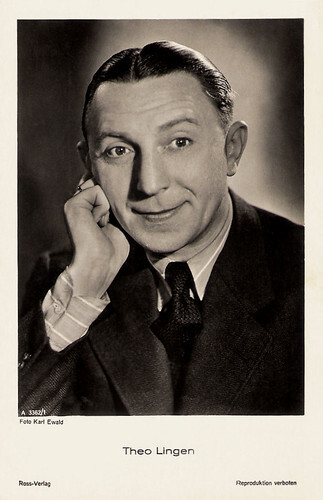
German postcard by Ross Verlag, no. A 3362/1, 1941-1944. Photo: Karl Ewald.
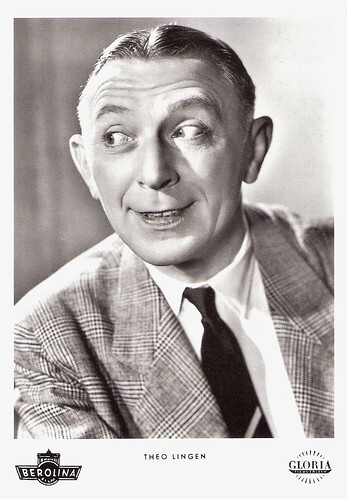
German postcard by K & B, Berlin, no. 51. Photo: Berolina Film / Gloria.
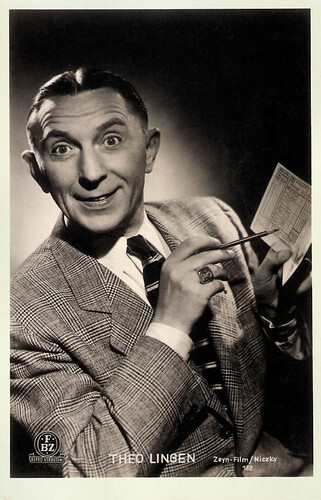
German postcard by FBZ, no. 132. Photo: Zeyn Film / Niczky. Theo Lingen in Der Theodor im Fußballtor / Theodor in the Football Goal (E.W. Emo, 1950).

German postcard. Photo: Allianz-Film. Theo Lingen in Die Diebin von Bagdad / The Thief of Bagdad (Karel Lamac, 1952).

German collector card. Theo Lingen and Elsbeth Sigmund in Heidi (Luigi Comencini, 1952).
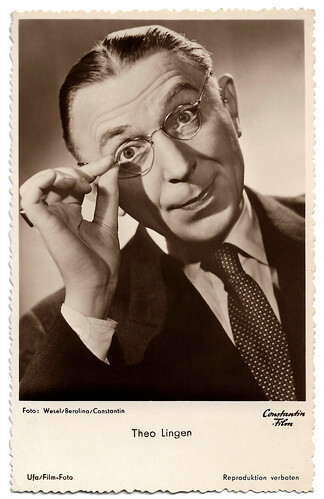
West German postcard by Ufa/Film-Foto. Photo: Wesel / Berlona / Constantin. Theo Lingen in Hurra - ein Junge! / Hooray - a boy! (Ernst Marischka, Georg Jacoby, 1953).
The Mayor of Strobl
In 1944, Theo Lingen moved to Vienna, and, given the approaching Red Army, retired to his cottage at Strobl on the Wolfgangsee shortly afterwards. For a few days in May 1945, he acted as de facto mayor. He managed to disempower the local Nazi authorities and surrendered to the US Army at St. Gilgen. After the war, Lingen first toured through Austrian cities with the artist collective Bad Ischl, and in 1946 he got Austrian nationality. From 1948 Lingen was an ensemble member at the famous Burgtheater in Vienna and played there until his death many character roles. He also appeared frequently onstage in Germany, most notably in Carl Sternheim satires directed by Rudolf Noelte.
The post-war cinema at first offered him leading roles in remakes of successful early sound films, in sportive slapstick comedies, and in sentimental regional films. Very funny is Jetzt schlägt’s 13/The Clock Ticks Thirteen (E.W. Emo, 1950) with Lingen and Hans Moser as two butlers who suspect each other of being mass murderers.
Other popular films were Heidi (Luigi Comencini, 1952), Pension Schöller (Georg Jacoby, 1960) and Bei Pichler stimmt die Kasse nicht/Pichler's Books Are Not in Order (Hans Quest, 1961) with Georg Thomalla .
During the 1960s German entertainment film sagged more and more into triviality. Lingen often had to impersonate hysterical characters in such slapstick comedies as Die Lümmel von der ersten Bank/To Hell with School (Werner Jacobs, 1968), Pepe, der Paukerschreck/Pepe: His Teacher's Fright (Harald Reinl, 1969) and Tante Trude aus Buxtehude/Aunt Trude from Buxtehude (Franz Josef Gottlieb, 1971) with TV star Rudi Carrell .
In the 1970s, he also worked in television, for example, as a presenter for Laurel and Hardy films. He also appeared in TV films and series and regularly performed on stage until 1971. Theo Lingen died of cancer in Vienna in 1978. He was 75. His daughter Ursula Lingen also became an actress. The city of Vienna dedicated an honorary grave to him at the Zentralfriedhof. The municipalities of Strobl and Lingen (in 2007) named squares in his honour.
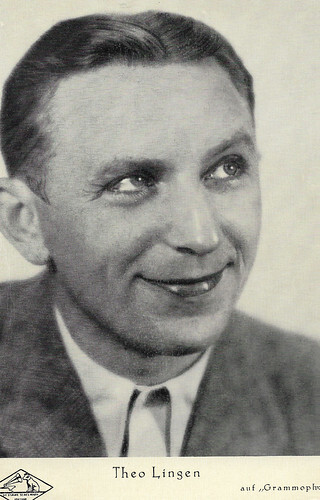
German postcard by Grammophon Die Stimme seines Herrn, no. 10648 E. Promotion for a record with the songs 'Eine goldige Frau' (A Woman of Gold) and 'Man darf bei den Mädels nicht schüchtern sein' (You Can't Be Shy With the Girls) from the film Die Austernlilli / The Oyster Lilli (E.W. Emo, 1937).

West German postcard by Kolibri-Verlag. Photo: Junge Film-Union / Saloga.
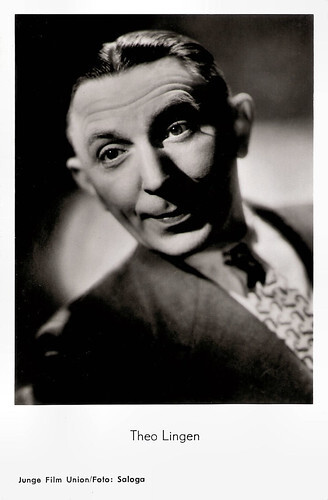
German postcard by Film-Postkartenverlag, Hamburg-Bergedorf, no. 138. Photo: Junge Film Union / Saloga.
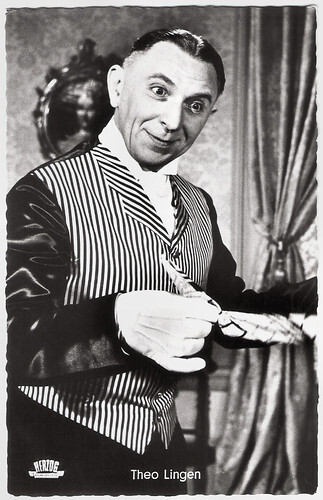
German postcard by Kolibri-Verlag G.m.b.H., Minden-Westf, no. 2022. Photo: Erma / Herzog-Film / Brünjes. Photo: Herzog-Film. Theo Lingen in Opernball / Opera Ball (Ernst Marischka, 1956).
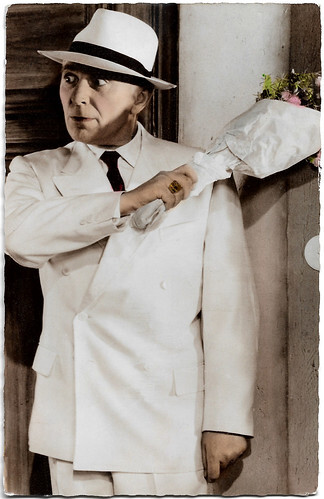
West German card. Theo Lingen in Mit Rosen fängt die Liebe an! / Love starts with roses (Peter Hamel, 1957).
Heli Finkenzeller , Theo Lingen and Marte Harell in the musical comedy Opernball/Opera Ball (Géza von Bolváry, 1939). Source: BD130 (YouTube).
Heinz Rühmann and Theo Lingen in the comedy Schäm' dich, Brigitte!/Shame on You, Brigitte! (1952). Source: BD130 (YouTube).
Sources: Thomas Staedeli (Cyranos), Stephanie D'heil (Steffi-line - German), Filmportal, Wikipedia and .

German collector card by Ross Verlag in the Bunte Filmbilder series for Martin Brinkmann A.G., Bremen, no. 53. Photo: Projektograph-Film. Theo Lingen in Wer zuletzt küßt… / Who kisses last... (E.W. Emo, 1936).

German collector card by Deutscher Verlag, Berlin, presented by Der Stern. Retail price: 10 Pfennig. Photo: Kurt Ullmann. Caption: Mann kann mich näher kennen lernen (Man can know more about me).

German postcard by Ross Verlag for Das Programm von Heute, Berlin. Photo: Syndikat-Film.

German postcard. Caricature drawing by Eberhard Renziehausen (Rienzi).

German postcard by Verlag und Druckerei Erwin Preuss, Dresden-Freital, Serie I Die neue farbige Filmstarkarte, no. 12. Photo: Charlott Serda.

German collector card. Theo Lingen in Heidi (Luigi Comencini, 1952).
Friendly villains
Theo Lingen was born Franz Theodor Schmitz in 1903 in Hanover, Germany. He attended the Royal Goethe Gymnasium – now Goethe School – in Hanover but left before taking the Abitur (final exams). His theatrical talent was discovered during rehearsals for a school performance.
Beginning his professional stage career at the Boulevardtheater Schauburg in Hannover in 1921, the 19-year-old actor adopted as a stage name his middle name together with that of the birthplace of his father, Lingen in the Emsland region of Germany. In the following years he played among others at the Stadttheater Münster, at the Neues Theater in Frankfurt and from 1931 at different places in Berlin. He didn't confine to acting but he also wrote theatre plays which he directed himself.
The film called him up in 1930. He appeared in over 230 films till 1978 and directed 21 films between 1936 and 1960. He played non-comic characters – and sometimes danced - in such musicals as Dolly macht Karriere/Dolly's Way to Stardom (Anatole Litvak, 1930) starring Dolly Haas , and Das Flötenkonzert von Sanssouci/The Flute Concert of Sans-Souci (Gustav Ucicky, 1930) and played friendly villains in the classics M (Fritz Lang, 1931) starring Peter Lorre and Das Testament des Dr. Mabuse/Dr. Mabuses Testament (Fritz Lang, 1933).
The funny effect which his performance had on the public, wasn't to be missed. From 1933 on comedy was his domain and the Austrian comic Hans Moser became his partner in 24 films.
Together they made a contrasting pair in such popular entertainment films as the operetta Rosen in Tirol/The Bird Seller (Géza von Bolváry, 1940), Wiener Blut/Vienna Blood (Willi Forst, 1942) starring Willy Fritsch , and the comedy Schäm' dich, Brigitte!/Shame on You, Brigitte! (E.W. Emo, 1952) with Heinz Rühmann .

German postcard by Ross Verlag, no. 8899/1, 1933-1934. Photo: Aafa-Film.

German postcard by Ross Verlag, no. 9424/1, 1935-1936. Photo: Zander & Labisch, Berlin.

German postcard by Ross Verlag, no. A 2068/7, 1939-1940. Photo: Willott, Berlin.

German postcard by Ross Verlag, no. A 3027/1, 1941-1944. Photo: Binz / Tobis.

German Postcard by Film Foto Verlag, no. A 3799/1, 1941-1944. Photo: Foto Binz, Berlin.

German postcard by Film Foto Verlag, no. A 3624/1, 1941-1944. Photo: Binz / Bavaria Filmkunst.
Special permission
From 1929 on, Theo Lingenperformed in Berlin, for instance as Macheath in Bertold Brecht's 'Dreigroschenoper'(The Threepenny Opera) at the Theater am Schiffbauerdamm, and in avantgarde plays, but also in cabaret and revue programmes at the Kurfürstendamm.
In February 1928, his daughter, Ursula, was born to Brecht's then-wife, singer Marianne Zoff. Brecht and Zoff divorced in September. Lingen and Zoff married later the same year and also raised Zoff's elder daughter Hanne. Conditions worsened after the 'Machtergreifung' of 30 January 1933. Zoff was half Jewish, which under the Nazi regime usually resulted in a 'Berufsverbot' (professional ban). Lingen thought about going into exile, but because of his great popularity with the general public Josef Goebbels gave him special permission to continue to perform and was able to protect his wife from persecution.
In 1936, Gustaf Gründgens brought him to the Preußische Staatstheater (the Berlin Prussian State Theatre), where Lingen stayed until 1944. During these years, he started to write his own plays. In most cases, Theo Lingen also directed the plays and played the leading role. Later, Lingen also wrote librettos for operas and operettas.
Lingen directed his first, short films in 1936, the four-part series of Till Eulenspiegel. From 1939 to 1956, he directed 18 feature films, including a buoyant film version of Paul Lincke's operetta Frau Luna/Mistress Moon (1941) with Lizzi Waldmüller , and Liebeskomödie/Comedy of Love (1942) with Magda Schneider .
Till the end of the war he acted in such popular comedies as Die Finanzen des Grossherzogs/The Grand Duke's Finances (Gustaf Gründgens, 1934), Der Himmel auf Erden/Heaven on Earth (E.W. Emo, 1935), Ich liebe alle Frauen/I Live All Women (Carl Lamac, 1935) starring Jan Kiepura , Der Mann, von dem man spricht/The Man, About Whom One Talks (E.W. Emo, 1937) with Heinz Rühmann , and Sieben Jahre Pech/Seven Years Hard Luck (Ernst Marischka, 1940). One of his most successful appearances was his double role of a building contractor and a servant in the film version of Lingen's own play Johann (Robert A. Stemmle, 1942).

German postcard by Ross Verlag, no. A 3362/1, 1941-1944. Photo: Karl Ewald.

German postcard by K & B, Berlin, no. 51. Photo: Berolina Film / Gloria.

German postcard by FBZ, no. 132. Photo: Zeyn Film / Niczky. Theo Lingen in Der Theodor im Fußballtor / Theodor in the Football Goal (E.W. Emo, 1950).

German postcard. Photo: Allianz-Film. Theo Lingen in Die Diebin von Bagdad / The Thief of Bagdad (Karel Lamac, 1952).

German collector card. Theo Lingen and Elsbeth Sigmund in Heidi (Luigi Comencini, 1952).

West German postcard by Ufa/Film-Foto. Photo: Wesel / Berlona / Constantin. Theo Lingen in Hurra - ein Junge! / Hooray - a boy! (Ernst Marischka, Georg Jacoby, 1953).
The Mayor of Strobl
In 1944, Theo Lingen moved to Vienna, and, given the approaching Red Army, retired to his cottage at Strobl on the Wolfgangsee shortly afterwards. For a few days in May 1945, he acted as de facto mayor. He managed to disempower the local Nazi authorities and surrendered to the US Army at St. Gilgen. After the war, Lingen first toured through Austrian cities with the artist collective Bad Ischl, and in 1946 he got Austrian nationality. From 1948 Lingen was an ensemble member at the famous Burgtheater in Vienna and played there until his death many character roles. He also appeared frequently onstage in Germany, most notably in Carl Sternheim satires directed by Rudolf Noelte.
The post-war cinema at first offered him leading roles in remakes of successful early sound films, in sportive slapstick comedies, and in sentimental regional films. Very funny is Jetzt schlägt’s 13/The Clock Ticks Thirteen (E.W. Emo, 1950) with Lingen and Hans Moser as two butlers who suspect each other of being mass murderers.
Other popular films were Heidi (Luigi Comencini, 1952), Pension Schöller (Georg Jacoby, 1960) and Bei Pichler stimmt die Kasse nicht/Pichler's Books Are Not in Order (Hans Quest, 1961) with Georg Thomalla .
During the 1960s German entertainment film sagged more and more into triviality. Lingen often had to impersonate hysterical characters in such slapstick comedies as Die Lümmel von der ersten Bank/To Hell with School (Werner Jacobs, 1968), Pepe, der Paukerschreck/Pepe: His Teacher's Fright (Harald Reinl, 1969) and Tante Trude aus Buxtehude/Aunt Trude from Buxtehude (Franz Josef Gottlieb, 1971) with TV star Rudi Carrell .
In the 1970s, he also worked in television, for example, as a presenter for Laurel and Hardy films. He also appeared in TV films and series and regularly performed on stage until 1971. Theo Lingen died of cancer in Vienna in 1978. He was 75. His daughter Ursula Lingen also became an actress. The city of Vienna dedicated an honorary grave to him at the Zentralfriedhof. The municipalities of Strobl and Lingen (in 2007) named squares in his honour.

German postcard by Grammophon Die Stimme seines Herrn, no. 10648 E. Promotion for a record with the songs 'Eine goldige Frau' (A Woman of Gold) and 'Man darf bei den Mädels nicht schüchtern sein' (You Can't Be Shy With the Girls) from the film Die Austernlilli / The Oyster Lilli (E.W. Emo, 1937).

West German postcard by Kolibri-Verlag. Photo: Junge Film-Union / Saloga.

German postcard by Film-Postkartenverlag, Hamburg-Bergedorf, no. 138. Photo: Junge Film Union / Saloga.

German postcard by Kolibri-Verlag G.m.b.H., Minden-Westf, no. 2022. Photo: Erma / Herzog-Film / Brünjes. Photo: Herzog-Film. Theo Lingen in Opernball / Opera Ball (Ernst Marischka, 1956).

West German card. Theo Lingen in Mit Rosen fängt die Liebe an! / Love starts with roses (Peter Hamel, 1957).
Heli Finkenzeller , Theo Lingen and Marte Harell in the musical comedy Opernball/Opera Ball (Géza von Bolváry, 1939). Source: BD130 (YouTube).
Heinz Rühmann and Theo Lingen in the comedy Schäm' dich, Brigitte!/Shame on You, Brigitte! (1952). Source: BD130 (YouTube).
Sources: Thomas Staedeli (Cyranos), Stephanie D'heil (Steffi-line - German), Filmportal, Wikipedia and .
Published on May 12, 2025 22:00
May 11, 2025
Ida Rubinstein
Ida Rubinstein (1885-1960) was a Russian-Ukrainian ballerina of the Ballets Russes, choreographer, actress and Maecenas from the Belle Epoque. After Rubinstein left the Ballets Russes, she founded her own dance company, the Ballet Ida Rubinstein, and had immediate success with 'Le Martyre de Saint Sébastien'(1911), with music by Claude Debussy, text by Gabriele D'Annunzio, and choreography by Michel Fokine and sets and costumes by Léon Bakst. She also appeared in two films, including the Italian slent drama La nave / The Ship (1921).
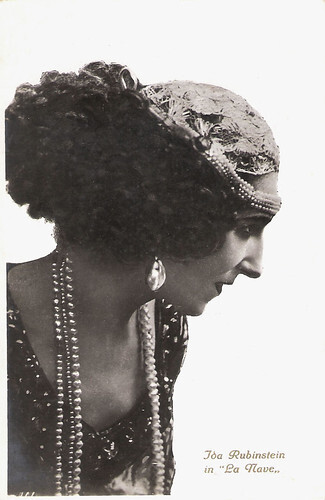
Italian postcard by G.B. Falci Edit., Milano Ida Rubinstein in the Italian silent film La nave / The Ship (Gabriellino D'Annunzio, Mario Roncoroni, 1921), based on the homonymous play by Gabriele D'Annunzio .
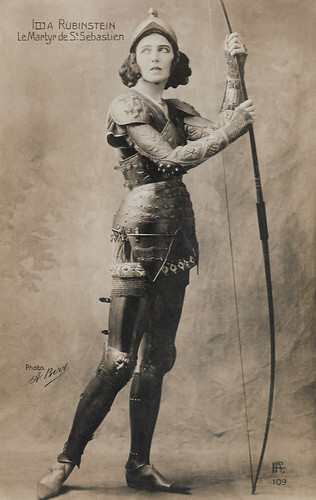
French postcard by RA, no. 109. Photo: A. Bert. Ida Rubinstein in 'Le Martyr de St. Sebastien' (1911).
The ship
Ida Rubinstein was a close friend of the poet and playwright Gabriele D'Annunzio . In 1921 she played the lead of Basiliola in the film La nave / The Ship (1921), directed by D'Annunzio's son Gabriellino D'Annunzio and by Mario Roncoroni. The film was based on a play by D'Annunzio, which already had been turned into an opera and had been filmed in 1912 by the company Ambrosio, but without much success.
Guido Marussig, who had designed both the play and the opera, designed sets and costumes for the 1921 film. The directors shot the film in a style typical of the later silent epics in Italy, denying innovation in film language and instead focusing on acting, set and costume design, harking back to earlier epics such as Cabiria, but adding cruelty and sadomasochism. La nave is set in early medieval times.
In the Venetian plains, at the town of Aquileia, Basiliola (Ida Rubinstein), daughter of the dethroned tribune Orso Faledro returns per ship and notices her father and brothers have been blinded by the Graticò brothers, of whom Marco (Alfredo Boccolini) is the new tribune and Sergio (Ciro Galvani) has become a bishop. Basiliola decides to ruin all involved.
In an extended dance scene, she seduces Sergio, the lecherous bishop. This film contains the only moving images of Rubinstein dancing and owes a great deal to Oscar Wilde's and Richard Strauss's 'Salomé'. Basiliola manages to have the soldiers arrested who were responsible for blinding her relatives. Through her femme fatale behaviour the men, locked in a pit, desire to be killed by her bow and arrows.
Basiliola also manages to set up the brothers against each other, with the younger brother Marco killing his older brother Sergio. Marco, though, realizes the danger of the temptress Basiliola and condemns her to be blinded too. After her death, the whole community leaves by ship to escape the nearing barbarians and to found a new, Christian community on a nearby island, Venice.
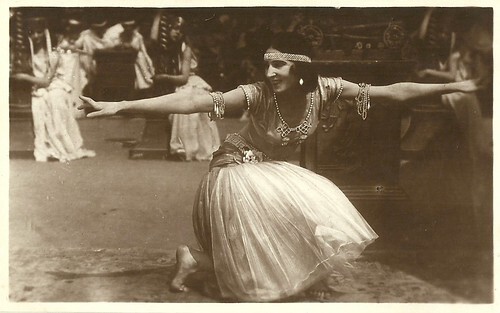
Italian postcard by Unione Cinematografica Italiana. Ida Rubinstein in La nave / The Ship (Gabriellino D'Annunzio, Mario Roncoroni, 1921).
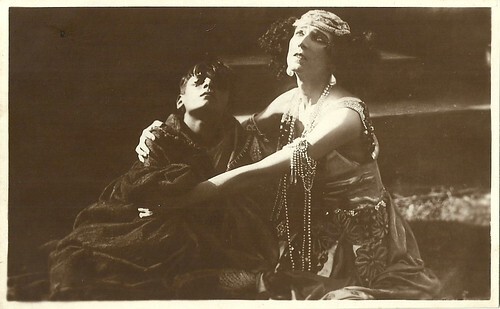
Italian postcard by Unione Cinematografica Italiana. Ida Rubinstein in La nave / The Ship (Gabriellino D'Annunzio, Mario Roncoroni, 1921).
The sad Venus
Ida Lvovna Rubinstein (Russian: Ида Львовна Рубинштейн) was born in Kharkov in the Russian Empire (now Kharkiv, Ukraine), in 1885, into a wealthy Jewish family. She was orphaned at a young age and left with a huge fortune. She went to a dance school in St. Petersburg, where she was trained by a.o. Michel Fokine.
She debuted in 1908 in Oscar Wilde's 'Salomé', where she performed the erotic dance of the seven veils. Shortly thereafter Sergei Diaghilev engaged her for his newly founded Ballets Russes in Paris.
There she danced the title role in 'Cléopâtre' (1909) and the role of Zobeide in 'Sheherazade' (1910), both in a choreography by her old teacher Fokine and with set and costume designs by Léon Bakst. In 'Shéhérazade', the legendary Vaslav Nijinsky was her partner. Rubinstein was praised for her sensual and opulent oriental dance style. She left the Ballets Russes in 1911.
Rubinstein was also known as a model in the art world. Her role in 'Cléopâtre' inspired Kees van Dongen for his painting 'Souvenir of the Russian Opera Season 1909'. Talk of the town was her nude portrait in 1910 by Valentin Serov. The Art Deco sculptor Demetre Chiparus made a bronze statue of her ('La danseuse'), to which a painting was made by Antonio de La Gandara.
The bisexual Rubinstein, a.k.a. La Venus triste, was entrusted to the canvas by the American female painter Romaine Brooks, with whom she had a relationship between 1911 and 1914. At that time, Rubinstein was a frequent patron of the art world and beau monde in Paris. She was friends with celebrities such as Sarah Bernhardt , Marc Chagall, Jean Cocteau and André Gide.
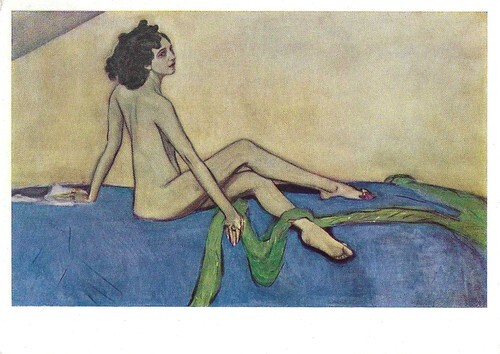
Soviet postcard by Aurora Art Publishers. Image: Nude portrait of Ida Rubinstein (1910) by Valentin Serov (1865-1911).
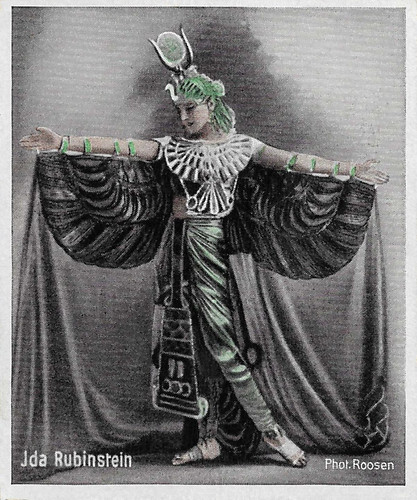
German cigarette card by Eckstein-Halpaus, Dresden, in the series 'Die Tanzbühnen der Welt', Group 2: Die Tanzbühnen des Auslandes (The dance stages of foreign countries), no. 86. Photo: Roosen. Caption: Ida Rubinstein, a famous Russian dance choreographer, who in recent years has presented her own ballet company in Paris with the participation of the most important contemporary artists.
A major theatre personality with charisma and acting talent
After Ida Rubinstein left the Ballets Russes, she founded her own dance company, the Ballet Ida Rubinstein. The company had immediate success with 'Le Martyre de Saint Sébastien' (1911), with music by Claude Debussy, text by Gabriele D'Annunzio , choreography by Michel Fokine and sets and costumes by Leon Bakst.
The press hailed the piece as a classic example of the 'stylised' modernism of those days. The archbishop of Paris criticised the fact that a Jewish woman performed the role of a Roman male saint.
Rubinstein is usually not counted among the greatest ballerinas, but she was a major theatre personality with charisma and acting talent. Moreover, due to her inherited wealth, she was able to engage the greatest composers and choreographers. She gave assignments to Maurice Ravel ('Boléro', 1928; 'La Valse', 1929) and Igor Stravinsky ('Le Baiser de la fée', 1928, 'Persephone', 1933).
In the twenties, she had her greatest successes with choreographies by Léonide Massine and Bronislava Nijinska. She also occasionally worked with the Ballets Russes. Rubinstein closed her company in 1935 and danced herself for the last time in 'Jeanne d'Arc au Bucher', Paris, in 1939.
In 1935 Ida Rubinstein took the French nationality. In 1940, after the start of World War II, she fled to London. She stayed in a suite at the Ritz Hotel and campaigned for wounded French soldiers. After the war, she returned to France and settled in Les Olivades in Vence, where she died on 20 September 1960.
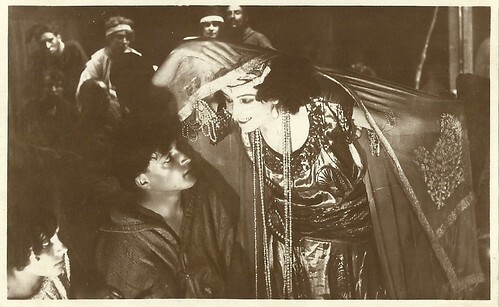
Italian postcard by Unione Cinematografica Italiana. Ida Rubinstein in La nave / The Ship (Gabriellino D'Annunzio, Mario Roncoroni, 1921).
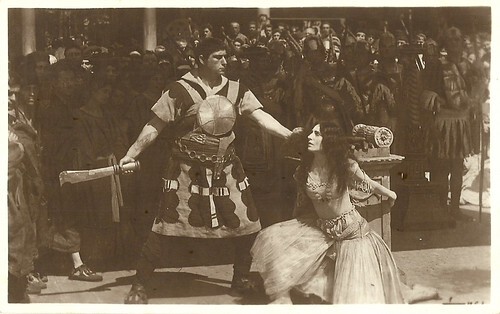
Italian postcard by Unione Cinematografica Italiana. Ida Rubinstein in La nave / The Ship (Gabriellino D'Annunzio, Mario Roncoroni, 1921).
Sources: Wikipedia ( and English), and .

Italian postcard by G.B. Falci Edit., Milano Ida Rubinstein in the Italian silent film La nave / The Ship (Gabriellino D'Annunzio, Mario Roncoroni, 1921), based on the homonymous play by Gabriele D'Annunzio .

French postcard by RA, no. 109. Photo: A. Bert. Ida Rubinstein in 'Le Martyr de St. Sebastien' (1911).
The ship
Ida Rubinstein was a close friend of the poet and playwright Gabriele D'Annunzio . In 1921 she played the lead of Basiliola in the film La nave / The Ship (1921), directed by D'Annunzio's son Gabriellino D'Annunzio and by Mario Roncoroni. The film was based on a play by D'Annunzio, which already had been turned into an opera and had been filmed in 1912 by the company Ambrosio, but without much success.
Guido Marussig, who had designed both the play and the opera, designed sets and costumes for the 1921 film. The directors shot the film in a style typical of the later silent epics in Italy, denying innovation in film language and instead focusing on acting, set and costume design, harking back to earlier epics such as Cabiria, but adding cruelty and sadomasochism. La nave is set in early medieval times.
In the Venetian plains, at the town of Aquileia, Basiliola (Ida Rubinstein), daughter of the dethroned tribune Orso Faledro returns per ship and notices her father and brothers have been blinded by the Graticò brothers, of whom Marco (Alfredo Boccolini) is the new tribune and Sergio (Ciro Galvani) has become a bishop. Basiliola decides to ruin all involved.
In an extended dance scene, she seduces Sergio, the lecherous bishop. This film contains the only moving images of Rubinstein dancing and owes a great deal to Oscar Wilde's and Richard Strauss's 'Salomé'. Basiliola manages to have the soldiers arrested who were responsible for blinding her relatives. Through her femme fatale behaviour the men, locked in a pit, desire to be killed by her bow and arrows.
Basiliola also manages to set up the brothers against each other, with the younger brother Marco killing his older brother Sergio. Marco, though, realizes the danger of the temptress Basiliola and condemns her to be blinded too. After her death, the whole community leaves by ship to escape the nearing barbarians and to found a new, Christian community on a nearby island, Venice.

Italian postcard by Unione Cinematografica Italiana. Ida Rubinstein in La nave / The Ship (Gabriellino D'Annunzio, Mario Roncoroni, 1921).

Italian postcard by Unione Cinematografica Italiana. Ida Rubinstein in La nave / The Ship (Gabriellino D'Annunzio, Mario Roncoroni, 1921).
The sad Venus
Ida Lvovna Rubinstein (Russian: Ида Львовна Рубинштейн) was born in Kharkov in the Russian Empire (now Kharkiv, Ukraine), in 1885, into a wealthy Jewish family. She was orphaned at a young age and left with a huge fortune. She went to a dance school in St. Petersburg, where she was trained by a.o. Michel Fokine.
She debuted in 1908 in Oscar Wilde's 'Salomé', where she performed the erotic dance of the seven veils. Shortly thereafter Sergei Diaghilev engaged her for his newly founded Ballets Russes in Paris.
There she danced the title role in 'Cléopâtre' (1909) and the role of Zobeide in 'Sheherazade' (1910), both in a choreography by her old teacher Fokine and with set and costume designs by Léon Bakst. In 'Shéhérazade', the legendary Vaslav Nijinsky was her partner. Rubinstein was praised for her sensual and opulent oriental dance style. She left the Ballets Russes in 1911.
Rubinstein was also known as a model in the art world. Her role in 'Cléopâtre' inspired Kees van Dongen for his painting 'Souvenir of the Russian Opera Season 1909'. Talk of the town was her nude portrait in 1910 by Valentin Serov. The Art Deco sculptor Demetre Chiparus made a bronze statue of her ('La danseuse'), to which a painting was made by Antonio de La Gandara.
The bisexual Rubinstein, a.k.a. La Venus triste, was entrusted to the canvas by the American female painter Romaine Brooks, with whom she had a relationship between 1911 and 1914. At that time, Rubinstein was a frequent patron of the art world and beau monde in Paris. She was friends with celebrities such as Sarah Bernhardt , Marc Chagall, Jean Cocteau and André Gide.

Soviet postcard by Aurora Art Publishers. Image: Nude portrait of Ida Rubinstein (1910) by Valentin Serov (1865-1911).

German cigarette card by Eckstein-Halpaus, Dresden, in the series 'Die Tanzbühnen der Welt', Group 2: Die Tanzbühnen des Auslandes (The dance stages of foreign countries), no. 86. Photo: Roosen. Caption: Ida Rubinstein, a famous Russian dance choreographer, who in recent years has presented her own ballet company in Paris with the participation of the most important contemporary artists.
A major theatre personality with charisma and acting talent
After Ida Rubinstein left the Ballets Russes, she founded her own dance company, the Ballet Ida Rubinstein. The company had immediate success with 'Le Martyre de Saint Sébastien' (1911), with music by Claude Debussy, text by Gabriele D'Annunzio , choreography by Michel Fokine and sets and costumes by Leon Bakst.
The press hailed the piece as a classic example of the 'stylised' modernism of those days. The archbishop of Paris criticised the fact that a Jewish woman performed the role of a Roman male saint.
Rubinstein is usually not counted among the greatest ballerinas, but she was a major theatre personality with charisma and acting talent. Moreover, due to her inherited wealth, she was able to engage the greatest composers and choreographers. She gave assignments to Maurice Ravel ('Boléro', 1928; 'La Valse', 1929) and Igor Stravinsky ('Le Baiser de la fée', 1928, 'Persephone', 1933).
In the twenties, she had her greatest successes with choreographies by Léonide Massine and Bronislava Nijinska. She also occasionally worked with the Ballets Russes. Rubinstein closed her company in 1935 and danced herself for the last time in 'Jeanne d'Arc au Bucher', Paris, in 1939.
In 1935 Ida Rubinstein took the French nationality. In 1940, after the start of World War II, she fled to London. She stayed in a suite at the Ritz Hotel and campaigned for wounded French soldiers. After the war, she returned to France and settled in Les Olivades in Vence, where she died on 20 September 1960.

Italian postcard by Unione Cinematografica Italiana. Ida Rubinstein in La nave / The Ship (Gabriellino D'Annunzio, Mario Roncoroni, 1921).

Italian postcard by Unione Cinematografica Italiana. Ida Rubinstein in La nave / The Ship (Gabriellino D'Annunzio, Mario Roncoroni, 1921).
Sources: Wikipedia ( and English), and .
Published on May 11, 2025 22:00
May 10, 2025
La croisiére noire (1926)
La croisière noire / The Black Journey (1926) is a French expedition film by Léon Poirier. The expedition was one of the publicity missions sponsored by André Citroën, with support from the Société de géographie and the Muséum national d'histoire naturelle, to promote his vehicles. The mission aimed to open a regular motor route in Africa and had political and cultural overtones. Starting at Béchaar, Algeria, on 28 October 1924, the expedition crossed the Sahara Desert and proceeded through Mali, Nigeria, Chad and Ubangi-Shari in French Equatorial Africa (AEF) and the Belgian Congo. The film and photos represent the European colonial gaze of a century ago, as this postcard series shows.
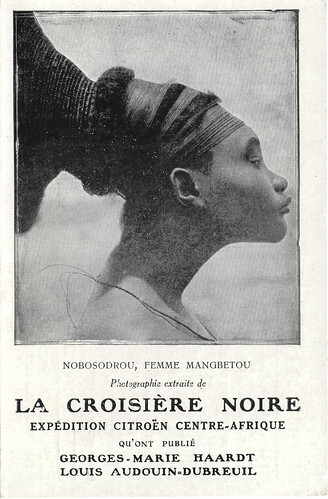
French postcard. Still from La croisière noire / The Black Journey (Léon Poirier, 1926). Caption: Nobosodrou, Femme Mangbetou. The Mangbetu are a Central Sudanic ethnic group in the Democratic Republic of the Congo, the former Belgian Congo. The Mangbetu, and in particular the elongated heads of the women, obtained by deforming the skulls of children from an early age, fascinated European explorers and writers from an early age.

French postcard by Ed. Expédition Citroën. Still from La croisière noire / The Black Journey (Léon Poirier, 1926). Caption: Beni-Abbès. Beni-Abbès is a town in western Algeria.
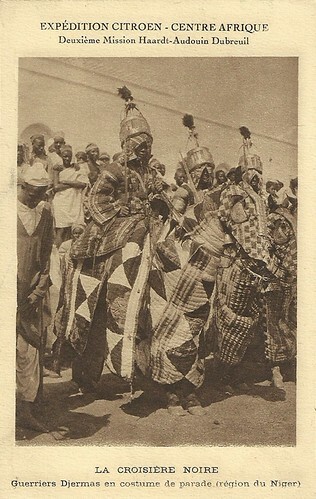
French postcard by Ed. Expédition Citroën. Still from La croisière noire / The Black Journey (Léon Poirier, 1926). Caption: Djerma warriors in parade costume (Niger). The Zarma people (also written as Djerma) are an ethnic group predominantly found in westernmost Niger.

French postcard by Ed. Expédition Citroën. Still from La croisière noire / The Black Journey (Léon Poirier, 1926). Caption: Arrival of the first cars at Lake Chad (14 December 1924).
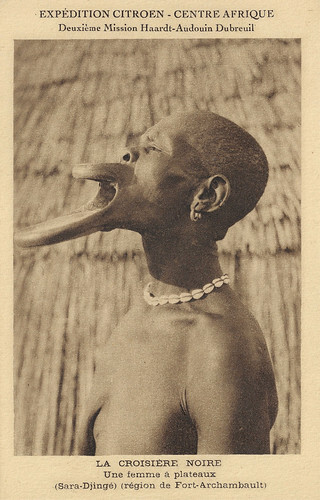
French postcard by Ed. Expédition Citroën. Still from La croisière noire / The Black Journey (Léon Poirier, 1926). Caption: A woman with lip plates (Sara-Djingé) (Sarh - formerly French colonial Fort Archambault). All the women of the Sara tribe in Sarh in Chad have this stretched labret piercing of the lips as a sign of beauty. The effect is produced by piercing the lips and gradually enlarging the holes by inserting wooden discs, the size of which is increased as the lips get distended.
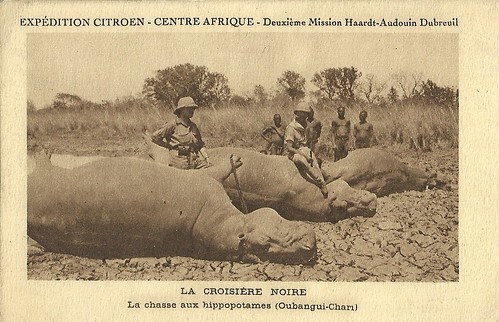
French postcard by Ed. Expédition Citroën. Still from La croisière noire / The Black Journey (Léon Poirier, 1926). Caption: Hippopotamus hunt (Ubangi-Shari). Ubangi-Shari was a French colony in Africa, part of French Equatorial Africa. It is now the Central African Republic.
An expedition with political and cultural overtones
La croisiére noire / The Black Journey (Léon Poirier, 1926) covers the second expedition organised by Georges-Marie Haardt and Louis Audouin-Dubreuil for Citroën. Léon Poirier directed the film, and Georges Specht was the cinematographer.
André Citroën sponsored these publicity missions, with support from the Société de géographie and the Muséum national d'histoire naturelle, to promote his vehicles. Citroën aimed to open a regular motor route in Africa, and the expedition also had political and cultural overtones.
The expedition started at Béchaar in Algeria on 28 October 1924. Then it crossed the Sahara Desert and proceeded through Mali, Nigeria, Chad and Ubangi-Shari in French Equatorial Africa (AEF) and the Belgian Congo.
The 17 members of the expedition included Haardt and Audouin-Dubreuil; cinematographer Léon Poirier with camera operator Georges Specht; Eugène Bergognier from the West African medical school; geologist Charles Brull; and the painter Alexandre Iacovleff. The group travelled in eight Citroën B2-based half-track cars, which had regular wheels in the front and continuous tracks in the rear.
The expedition took place in October 1924, while Poirier's film premiered in 1926. Loads of photos were exhibited too, e.g. at the Louvre in 1926. The collection of 207 photographs taken during the expedition was likely made by one or more of the expedition's participants.
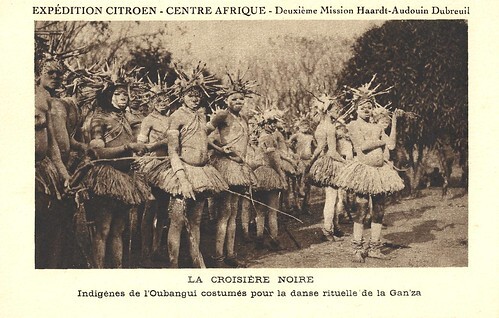
French postcard by Ed. Expédition Citroën. Still from La croisière noire / The Black Journey (Léon Poirier, 1926). Caption: Indigenous Ubangi dressed for the ritual dance of the Gan'za. Ubangi-Shari was a French colony in Africa, part of French Equatorial Africa. It is now the Central African Republic.
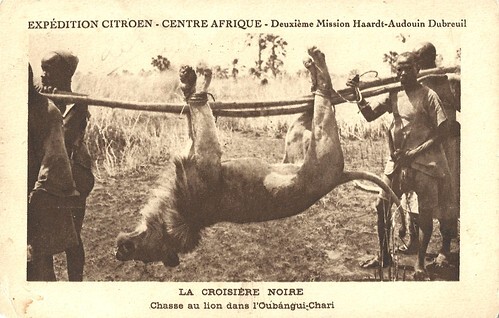
French postcard by Ed. Expédition Citroën. Still from La croisière noire / The Black Journey (Léon Poirier, 1926). Caption: Lion hunt in Ubangi-Shari.
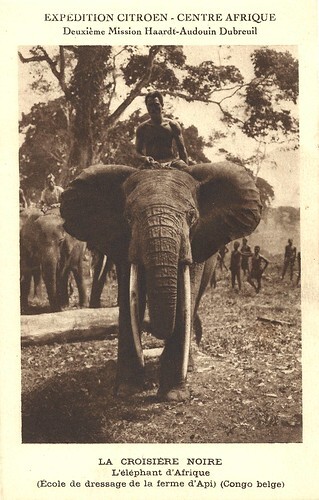
French postcard by Ed. Expédition Citroën. Still from La croisière noire / The Black Journey (Léon Poirier, 1926). Caption: African elephant (Api Elephant Domestication Centre, Belgian Congo). Belgian Congo is now the Democratic Republic of the Congo.
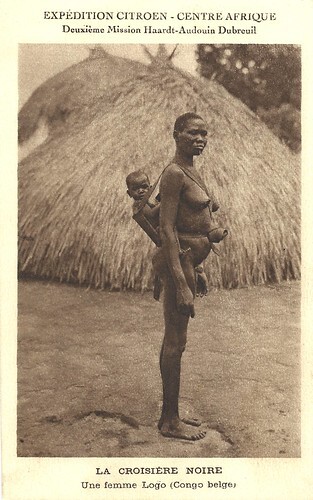
French postcard by Ed. Expédition Citroën. Still from La croisière noire / The Black Journey (Léon Poirier, 1926). Caption: Woman of the Logo (Belgian Congo - now the Democratic Republic of the Congo. The Logo people or Logoa (plural) are an ethnic group of Nilotic origin who live predominantly in the north-east of the Democratic Republic of the Congo, as well as parts of western Uganda and southern South Sudan.
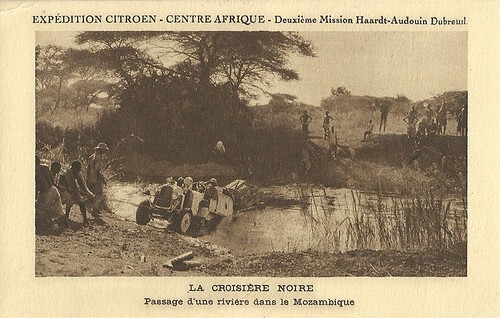
French postcard by Ed. Expédition Citroën. Still from La croisière noire / The Black Journey (Léon Poirier, 1926). Caption: Crossing a river in Mozambique.
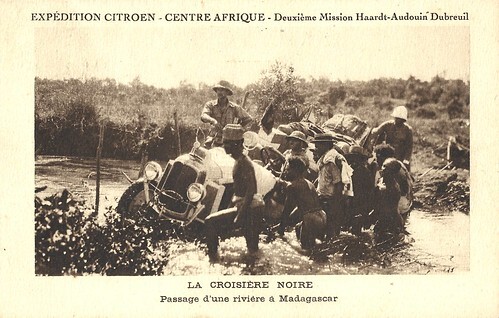
French postcard by Ed. Expédition Citroën. Still from La croisière noire / The Black Journey (Léon Poirier, 1926). Caption: Crossing a river in Madagascar.
Source: ArchiveGrid and Wikipedia.

French postcard. Still from La croisière noire / The Black Journey (Léon Poirier, 1926). Caption: Nobosodrou, Femme Mangbetou. The Mangbetu are a Central Sudanic ethnic group in the Democratic Republic of the Congo, the former Belgian Congo. The Mangbetu, and in particular the elongated heads of the women, obtained by deforming the skulls of children from an early age, fascinated European explorers and writers from an early age.

French postcard by Ed. Expédition Citroën. Still from La croisière noire / The Black Journey (Léon Poirier, 1926). Caption: Beni-Abbès. Beni-Abbès is a town in western Algeria.

French postcard by Ed. Expédition Citroën. Still from La croisière noire / The Black Journey (Léon Poirier, 1926). Caption: Djerma warriors in parade costume (Niger). The Zarma people (also written as Djerma) are an ethnic group predominantly found in westernmost Niger.

French postcard by Ed. Expédition Citroën. Still from La croisière noire / The Black Journey (Léon Poirier, 1926). Caption: Arrival of the first cars at Lake Chad (14 December 1924).

French postcard by Ed. Expédition Citroën. Still from La croisière noire / The Black Journey (Léon Poirier, 1926). Caption: A woman with lip plates (Sara-Djingé) (Sarh - formerly French colonial Fort Archambault). All the women of the Sara tribe in Sarh in Chad have this stretched labret piercing of the lips as a sign of beauty. The effect is produced by piercing the lips and gradually enlarging the holes by inserting wooden discs, the size of which is increased as the lips get distended.

French postcard by Ed. Expédition Citroën. Still from La croisière noire / The Black Journey (Léon Poirier, 1926). Caption: Hippopotamus hunt (Ubangi-Shari). Ubangi-Shari was a French colony in Africa, part of French Equatorial Africa. It is now the Central African Republic.
An expedition with political and cultural overtones
La croisiére noire / The Black Journey (Léon Poirier, 1926) covers the second expedition organised by Georges-Marie Haardt and Louis Audouin-Dubreuil for Citroën. Léon Poirier directed the film, and Georges Specht was the cinematographer.
André Citroën sponsored these publicity missions, with support from the Société de géographie and the Muséum national d'histoire naturelle, to promote his vehicles. Citroën aimed to open a regular motor route in Africa, and the expedition also had political and cultural overtones.
The expedition started at Béchaar in Algeria on 28 October 1924. Then it crossed the Sahara Desert and proceeded through Mali, Nigeria, Chad and Ubangi-Shari in French Equatorial Africa (AEF) and the Belgian Congo.
The 17 members of the expedition included Haardt and Audouin-Dubreuil; cinematographer Léon Poirier with camera operator Georges Specht; Eugène Bergognier from the West African medical school; geologist Charles Brull; and the painter Alexandre Iacovleff. The group travelled in eight Citroën B2-based half-track cars, which had regular wheels in the front and continuous tracks in the rear.
The expedition took place in October 1924, while Poirier's film premiered in 1926. Loads of photos were exhibited too, e.g. at the Louvre in 1926. The collection of 207 photographs taken during the expedition was likely made by one or more of the expedition's participants.

French postcard by Ed. Expédition Citroën. Still from La croisière noire / The Black Journey (Léon Poirier, 1926). Caption: Indigenous Ubangi dressed for the ritual dance of the Gan'za. Ubangi-Shari was a French colony in Africa, part of French Equatorial Africa. It is now the Central African Republic.

French postcard by Ed. Expédition Citroën. Still from La croisière noire / The Black Journey (Léon Poirier, 1926). Caption: Lion hunt in Ubangi-Shari.

French postcard by Ed. Expédition Citroën. Still from La croisière noire / The Black Journey (Léon Poirier, 1926). Caption: African elephant (Api Elephant Domestication Centre, Belgian Congo). Belgian Congo is now the Democratic Republic of the Congo.

French postcard by Ed. Expédition Citroën. Still from La croisière noire / The Black Journey (Léon Poirier, 1926). Caption: Woman of the Logo (Belgian Congo - now the Democratic Republic of the Congo. The Logo people or Logoa (plural) are an ethnic group of Nilotic origin who live predominantly in the north-east of the Democratic Republic of the Congo, as well as parts of western Uganda and southern South Sudan.

French postcard by Ed. Expédition Citroën. Still from La croisière noire / The Black Journey (Léon Poirier, 1926). Caption: Crossing a river in Mozambique.

French postcard by Ed. Expédition Citroën. Still from La croisière noire / The Black Journey (Léon Poirier, 1926). Caption: Crossing a river in Madagascar.
Source: ArchiveGrid and Wikipedia.
Published on May 10, 2025 22:00
May 9, 2025
Ellen ten Damme
Ellen ten Damme (1967) is a Dutch actress, singer-songwriter and multi-instrumentalist. She appeared in numerous Dutch and German television series and films. As a singer, Ten Damme performs as a solo artist and with bands.
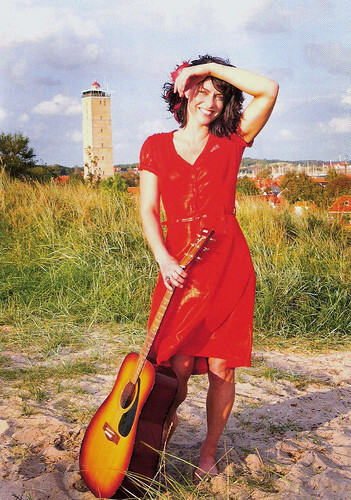
Dutch postcard by Art Unlimited, Amsterdam, no. U 1162. Photo: Gerry Hurkmans, 2009.

Dutch postcard by Boomerang School Cards for CJP, no WK06-03. Caption: See You Soon (CUSoon).
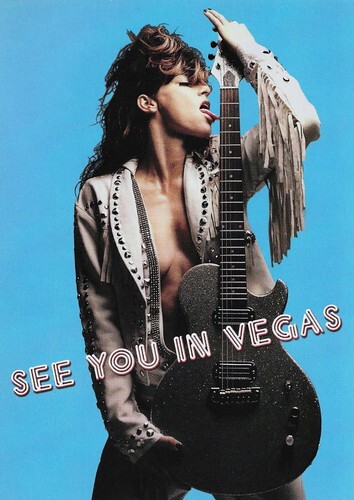
Dutch postcard by Boomerang, Amsterdam, no. P25-02. Photo: Sony Music. Promotion card for the single 'See you in Vegas'.
Rebellious behaviour and acrobatic theatre shows
Ellen ten Damme was born in Warnsveld, The Netherlands in 1967. She grew up in Roden, a municipality in the province of Drenthe. Ellen attended Nienoord College in Leek, in the province of Groningen, and studied Dutch literature at the University of Groningen for several years. Finally, she graduated from the Academie voor Kleinkunst in Amsterdam, where she concentrated on piano playing. Later, she also took up the violin and guitar. As a result of her extreme shyness as a child, she wanted to express herself by dressing in brightly coloured clothes, which her mother condemned.
Later, she expressed this through her rebellious behaviour and performances in bands. She then found her way by expressing herself in a variety of art forms. As a teenager, she was a top gymnast and trained about three hours a day. She quit gymnastics at 16, but in doing so, she had laid the foundation for her sometimes acrobatic theatre shows.
Ten Damme made her acting debut as Maria Machita in Paul Ruven's short musical film De tranen van Maria Machita / The Tears of Maria Machita (1991), for which she was nominated for a Golden Calf Award in the Best Actress category. She played the role of Dédé in De kleine blonde dood / The Little Blonde Death (Jean van de Velde, 1993) with Antonie Kamerling and Olivier Tuinier. It won the Golden Calf for Best Feature Film. She gained greater fame as the sidekick Joosje in the acclaimed lawyer drama series Pleidooi / Plea (Mike van Diem, a.o., 1993-1995). She also had a recurring guest role in the cult TV show Jiskefet (1995-1997).
Ellen ten Damme started to work in Germany and starred in the romantic Heimatfilm Westerwald / Wild Western Forest (Bernd Löhr, 1995). Dutch films such as All Stars (Jean van de Velde, 1997) with Daniël Boissevain and Antonie Kamerling , and No Trains No Planes (Jos Stelling, 1999) with Kees Prins and Katja Schuurman followed. A blockbuster in the Netherlands was the coming-of-age film Volle Maan / Full Moon Party (Johan Nijenhuis, 2002) with Daan Schuurmans, Cas Jansen and Michiel Huisman.
In 2000, Ten Damme played an English language leading role in the Irish film drama Conamara (Eoin Moore, 2000). She also had supporting roles in the Dutch film Interview (Theo van Gogh, 2003) starring Katja Schuurman and Pierre Bokma and in the family film trilogy Mijn vader is een detective / My Father is a Detective (Will Wissink, 2009-2012) with Cees Geel. She appeared again alongside Pierre Bokma in an episode of the British TV series Dalziel and Pascoe (2006). In Germany, she acted in the TV film Das Leuchten der Sterne / The Shining of the Stars (Adolf Winkelmann, 2007) as the mother of a terminally ill disabled boy and played in two episodes of the popular Krimi series Tatort / Crime Scene (2002-2019).
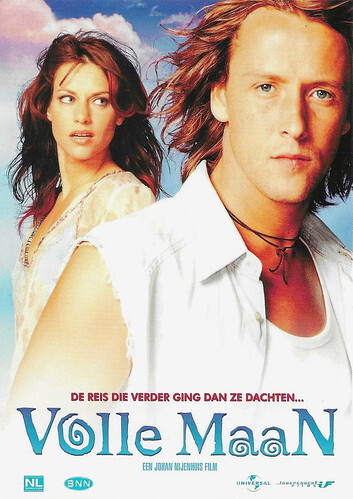
Dutch freecard by Boomerang, Amsterdam, no. P21-02. Photo: Ray Christian / De Kroon Studio / Nijenhuis & Levita / BNN / Universal / Independent Films. Ellen ten Damme and Daan Schuurmans in Volle maan / Full Moon Party (Johan Nijenhuis, 2002).
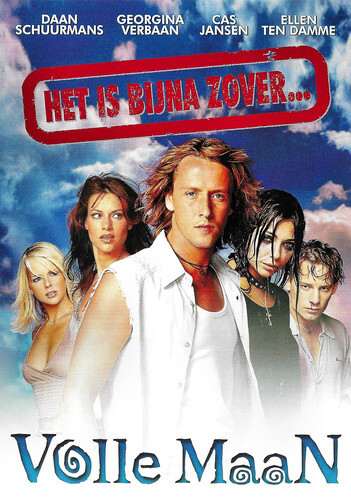
Dutch freecard by Boomerang, Amsterdam, no. WK08-03. Photo: Ray Christian / De Kroon Studio / Nijenhuis & Levita / BNN / Universal / Independent Films. Daan Schuurmans, Ellen ten Damme, Georgina Verbaan, Cas Jansen and Chantal Janzen in Volle maan (2002), in Volle maan / Full Moon Party (Johan Nijenhuis, 2002).
Plattgefickt
Ellen ten Damme sang on several film soundtracks, including the clueless comedy Honneponnetje / Honeybun (Ruud van Hemert, 1988). She was almost chosen for the leading role in the film, and the producers felt sorry for her because she didn't get the part, so she was chosen to sing for the soundtrack the song 'Trust in a Feeling'. She recorded it as a single under the name Ellen D. As a singer, she performed in 1996–1997 with the new wave band Soviet Sex, which featured painter/photographer Peter Klashorst.
Solo, she released the albums 'Kill Your Darlings' (1995), 'I Am Here' (2001), 'Impossible Girl' (2007), 'Durf jij?' (Dare You?, 2009), 'Het regende zon' (It Rained Sun, 2012), the German-language album 'Berlin' (2014), the French-language album 'Paris' (2017) and 'Casablanca' (2019). The last three she made with the Magpie Orchestra. Often, the albums were followed by tours. In 2002, she had a chart success in the Netherlands with the song 'Vegas'. In the clip, she kisses actress Katja Schuurman, who is dressed in a wedding dress.
Ten Damme is well known in Germany thanks to her roles in several (television) films and her performances. She speaks and sings German with virtually no accent. In 2003–2004, she accompanied German rock musician Udo Lindenberg on the tour for his album 'Atlantic Affairs'. In 2005, Ten Damme took part in the German preselection of the Eurovision Song Contest with the song 'Plattgeliebt', composed by Udo Lindenberg. She did not win. The song's title was originally 'Plattgefickt' (fucked flat), but was tactically changed to 'Plattgeliebt' by Udo Lindenberg. The song is an anti-war song directed against George W. Bush and his policies on Iraq.
In August 2009, Ten Damme performed in the international circus show 'Cirque Stiletto' directed by Stanley Burleson. This was followed by the theatre tour 'Durf jij? in which she sang Dutch songs by poet Ilja Leonard Pfeijffer. For both performances, she received the Gouden Notekraker (Golden Nutcracker Award). In 2013, she featured alongside Waldemar Torenstra in the World War II theatre comedy 'To Be or Not to Be', based on the Ernst Lubitsch film of the same name. In 2016, she performed as Maria in the music event 'The Passion'.
From 1998 to 2004, Ellen ten Damme was married to German actor Markus Knüfken, with whom she acted in the dark crime comedy Bang Boom Bang - Ein todsicheres Ding / A Sure Thing (Peter Thorwarth, 1999). She then had a long-term relationship with guitarist Robin Berlin and then with photographer Danny Ellinger. Since 2020, she has been with pianist Ringo Maurer. Ten Damme contracted breast cancer three times and healed from it all three times, in 2005, 2017 and 2022. In 2022, Ten Damme stated to the public prosecutor that rapper Ali B had raped her during the filming of the TV show Ali B and the Music Caravan in 2014. Her statements were included in the trial against Ali B. He was found guilty by the judge in 2024 of the attempted rape of Ten Damme and rape in another case. Ellen ten Damme's most recent film is Paradijs / Paradise (Bobbie Koek, 2024).
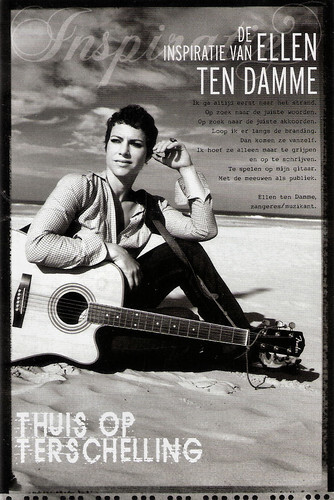
Dutch postcard by Thuis op Terschelling. Caption: Ellen ten Damme's inspiration. I always go to the beach first. In search of the right words. Looking for the right chords. I walk along the beach. Then, they come naturally. All I have to do is grab them and write them down. To play on my guitar. With the seagulls as an audience. Ellen ten Damme, singer/musician.
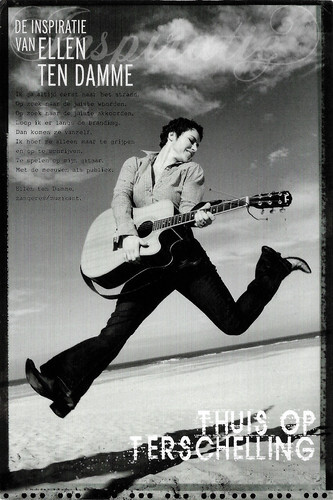
Dutch postcard by Thuis op Terschelling.
Sources: Wikipedia (Dutch, English and German) and .

Dutch postcard by Art Unlimited, Amsterdam, no. U 1162. Photo: Gerry Hurkmans, 2009.

Dutch postcard by Boomerang School Cards for CJP, no WK06-03. Caption: See You Soon (CUSoon).

Dutch postcard by Boomerang, Amsterdam, no. P25-02. Photo: Sony Music. Promotion card for the single 'See you in Vegas'.
Rebellious behaviour and acrobatic theatre shows
Ellen ten Damme was born in Warnsveld, The Netherlands in 1967. She grew up in Roden, a municipality in the province of Drenthe. Ellen attended Nienoord College in Leek, in the province of Groningen, and studied Dutch literature at the University of Groningen for several years. Finally, she graduated from the Academie voor Kleinkunst in Amsterdam, where she concentrated on piano playing. Later, she also took up the violin and guitar. As a result of her extreme shyness as a child, she wanted to express herself by dressing in brightly coloured clothes, which her mother condemned.
Later, she expressed this through her rebellious behaviour and performances in bands. She then found her way by expressing herself in a variety of art forms. As a teenager, she was a top gymnast and trained about three hours a day. She quit gymnastics at 16, but in doing so, she had laid the foundation for her sometimes acrobatic theatre shows.
Ten Damme made her acting debut as Maria Machita in Paul Ruven's short musical film De tranen van Maria Machita / The Tears of Maria Machita (1991), for which she was nominated for a Golden Calf Award in the Best Actress category. She played the role of Dédé in De kleine blonde dood / The Little Blonde Death (Jean van de Velde, 1993) with Antonie Kamerling and Olivier Tuinier. It won the Golden Calf for Best Feature Film. She gained greater fame as the sidekick Joosje in the acclaimed lawyer drama series Pleidooi / Plea (Mike van Diem, a.o., 1993-1995). She also had a recurring guest role in the cult TV show Jiskefet (1995-1997).
Ellen ten Damme started to work in Germany and starred in the romantic Heimatfilm Westerwald / Wild Western Forest (Bernd Löhr, 1995). Dutch films such as All Stars (Jean van de Velde, 1997) with Daniël Boissevain and Antonie Kamerling , and No Trains No Planes (Jos Stelling, 1999) with Kees Prins and Katja Schuurman followed. A blockbuster in the Netherlands was the coming-of-age film Volle Maan / Full Moon Party (Johan Nijenhuis, 2002) with Daan Schuurmans, Cas Jansen and Michiel Huisman.
In 2000, Ten Damme played an English language leading role in the Irish film drama Conamara (Eoin Moore, 2000). She also had supporting roles in the Dutch film Interview (Theo van Gogh, 2003) starring Katja Schuurman and Pierre Bokma and in the family film trilogy Mijn vader is een detective / My Father is a Detective (Will Wissink, 2009-2012) with Cees Geel. She appeared again alongside Pierre Bokma in an episode of the British TV series Dalziel and Pascoe (2006). In Germany, she acted in the TV film Das Leuchten der Sterne / The Shining of the Stars (Adolf Winkelmann, 2007) as the mother of a terminally ill disabled boy and played in two episodes of the popular Krimi series Tatort / Crime Scene (2002-2019).

Dutch freecard by Boomerang, Amsterdam, no. P21-02. Photo: Ray Christian / De Kroon Studio / Nijenhuis & Levita / BNN / Universal / Independent Films. Ellen ten Damme and Daan Schuurmans in Volle maan / Full Moon Party (Johan Nijenhuis, 2002).

Dutch freecard by Boomerang, Amsterdam, no. WK08-03. Photo: Ray Christian / De Kroon Studio / Nijenhuis & Levita / BNN / Universal / Independent Films. Daan Schuurmans, Ellen ten Damme, Georgina Verbaan, Cas Jansen and Chantal Janzen in Volle maan (2002), in Volle maan / Full Moon Party (Johan Nijenhuis, 2002).
Plattgefickt
Ellen ten Damme sang on several film soundtracks, including the clueless comedy Honneponnetje / Honeybun (Ruud van Hemert, 1988). She was almost chosen for the leading role in the film, and the producers felt sorry for her because she didn't get the part, so she was chosen to sing for the soundtrack the song 'Trust in a Feeling'. She recorded it as a single under the name Ellen D. As a singer, she performed in 1996–1997 with the new wave band Soviet Sex, which featured painter/photographer Peter Klashorst.
Solo, she released the albums 'Kill Your Darlings' (1995), 'I Am Here' (2001), 'Impossible Girl' (2007), 'Durf jij?' (Dare You?, 2009), 'Het regende zon' (It Rained Sun, 2012), the German-language album 'Berlin' (2014), the French-language album 'Paris' (2017) and 'Casablanca' (2019). The last three she made with the Magpie Orchestra. Often, the albums were followed by tours. In 2002, she had a chart success in the Netherlands with the song 'Vegas'. In the clip, she kisses actress Katja Schuurman, who is dressed in a wedding dress.
Ten Damme is well known in Germany thanks to her roles in several (television) films and her performances. She speaks and sings German with virtually no accent. In 2003–2004, she accompanied German rock musician Udo Lindenberg on the tour for his album 'Atlantic Affairs'. In 2005, Ten Damme took part in the German preselection of the Eurovision Song Contest with the song 'Plattgeliebt', composed by Udo Lindenberg. She did not win. The song's title was originally 'Plattgefickt' (fucked flat), but was tactically changed to 'Plattgeliebt' by Udo Lindenberg. The song is an anti-war song directed against George W. Bush and his policies on Iraq.
In August 2009, Ten Damme performed in the international circus show 'Cirque Stiletto' directed by Stanley Burleson. This was followed by the theatre tour 'Durf jij? in which she sang Dutch songs by poet Ilja Leonard Pfeijffer. For both performances, she received the Gouden Notekraker (Golden Nutcracker Award). In 2013, she featured alongside Waldemar Torenstra in the World War II theatre comedy 'To Be or Not to Be', based on the Ernst Lubitsch film of the same name. In 2016, she performed as Maria in the music event 'The Passion'.
From 1998 to 2004, Ellen ten Damme was married to German actor Markus Knüfken, with whom she acted in the dark crime comedy Bang Boom Bang - Ein todsicheres Ding / A Sure Thing (Peter Thorwarth, 1999). She then had a long-term relationship with guitarist Robin Berlin and then with photographer Danny Ellinger. Since 2020, she has been with pianist Ringo Maurer. Ten Damme contracted breast cancer three times and healed from it all three times, in 2005, 2017 and 2022. In 2022, Ten Damme stated to the public prosecutor that rapper Ali B had raped her during the filming of the TV show Ali B and the Music Caravan in 2014. Her statements were included in the trial against Ali B. He was found guilty by the judge in 2024 of the attempted rape of Ten Damme and rape in another case. Ellen ten Damme's most recent film is Paradijs / Paradise (Bobbie Koek, 2024).

Dutch postcard by Thuis op Terschelling. Caption: Ellen ten Damme's inspiration. I always go to the beach first. In search of the right words. Looking for the right chords. I walk along the beach. Then, they come naturally. All I have to do is grab them and write them down. To play on my guitar. With the seagulls as an audience. Ellen ten Damme, singer/musician.

Dutch postcard by Thuis op Terschelling.
Sources: Wikipedia (Dutch, English and German) and .
Published on May 09, 2025 22:00
Paul van Yperen's Blog
- Paul van Yperen's profile
- 13 followers
Paul van Yperen isn't a Goodreads Author
(yet),
but they
do have a blog,
so here are some recent posts imported from
their feed.



